DINING ON THE BAY Southern Roots at the Grand Hotel




DINING ON THE BAY Southern Roots at the Grand Hotel



ALABAMA LIVING is delivered to some 450,000 Alabama families and businesses, which are members of 22 not-for-profit, consumer-owned, locally directed and taxpaying electric cooperatives. Subscriptions are $15 a year for individuals not subscribing through participating Alabama electric cooperatives. Alabama Living (USPS 029-920) is published monthly by the Alabama Rural Electric Association of Cooperatives. Periodicals postage paid at Montgomery, Alabama, and at additional mailing office.
ALABAMA RURAL ELECTRIC ASSOCIATION
AREA President
Karl Rayborn
Editor Lenore Vickrey
Managing Editor
Allison Law
Senior Graphic Designer
Sean Burnley
Art Director
Danny Weston
Advertising Director
Jacob Johnson
Graphic Designer/Production Coordinator
Brooke Echols
ADVERTISING & EDITORIAL OFFICES:
340 TechnaCenter Drive
Montgomery, Alabama 36117-6031
1-800-410-2737
For advertising, email: advertising@areapower.com
For editorial inquiries, email: contact@alabamaliving.coop
NATIONAL ADVERTISING REPRESENTATIVE:
American MainStreet Publications
611 South Congress Ave., Suite 504 Austin, Texas 78704
1-800-626-1181
www.AMP.coop
www.alabamaliving.coop


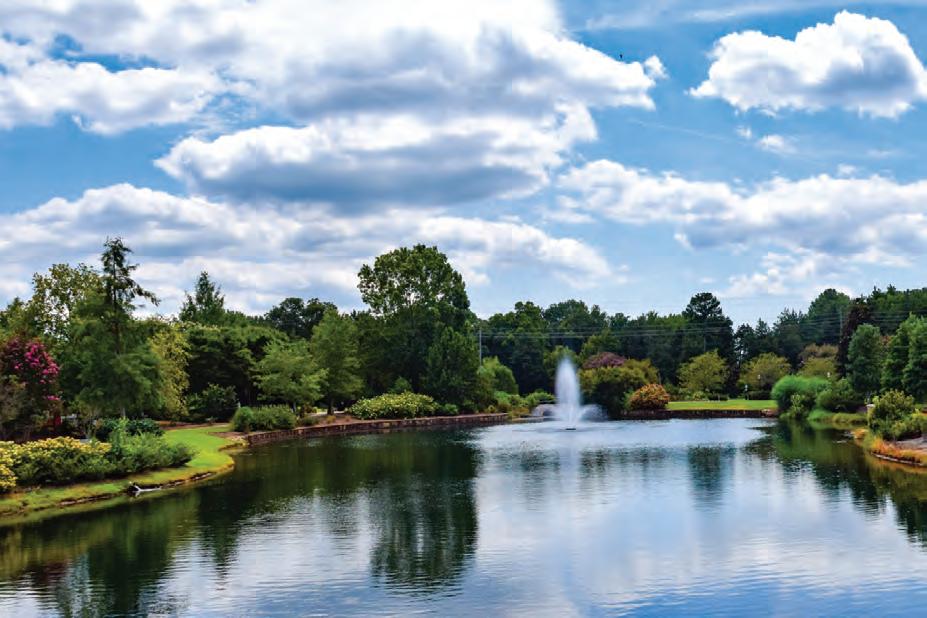

Huntsville’s Botanical Gardens are arranged around Little Smith Lake, just behind the Guest Center, with an astonishing diversity of features for visitors to discover, including azaleas, dogwoods, birding trails, a stunning aquatic garden and numerous other themed gardens.
Highlights from our readers’ favorite photos they send us throughout the year.
Reenactors often perform in living history programs at Fort Morgan, where Confederate soldiers faced many hardships. 30
Spectacular sunsets while dining on fresh Gulf seafood await visitors to Southern Roots at the Grand Hotel.

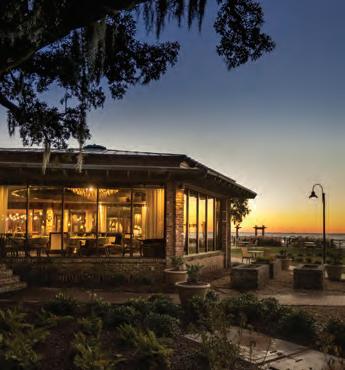


By Michael Leitman

Providing members with safe, reliable and affordable power is the mantra for electric cooperatives across the nation. Co-op members can see the work necessary to maintain reliable electricity at the local level, such as co-op lineworkers maintaining utility poles and wires and repairing them after major storms. At the regional and national levels, a diverse mix of power generation resources, transmission lines and pipeline infrastructure are essential cornerstones of maintaining reliable electricity.
The U.S. electric grid has undergone major changes over the last decade. The share of electricity generated from coal plants has declined significantly, while the share from natural gas and intermittent wind and solar generation has grown. Fuel diversity means that your electricity is supplied by a variety of generation technologies, each with their own characteristics and performance capabilities over different weather and seasonal conditions.
Dispatchable technologies can be turned on and off as needed. Large steam generation plants (most commonly using coal or nuclear fuels) are generally considered “baseload,” meaning that they are designed to run efficiently 24/7 to serve as the base of the electricity mix. However, steam plants are less capable of ramping output up or down to meet the various peaks and dips as grid conditions change.
Natural gas is the most versatile fuel, powering large combined-cycle plants that can operate as baseload but are also more flexible ramping up and down. These capabilities are essential for meeting demand on the hottest and coldest days, and for balancing intermittent renewable energy sources, such as solar and wind.
Most hydroelectric power comes from generators inside large dams, like the Snake River Dams in the Pacific Northwest, which can be dispatched when needed––as long as there is enough water available.
Over the last decade, the share of electricity generated from wind and solar plants has increased dramatically. These beneficial, “no-fuel-required” plants can deliver low-cost electricity––but they only generate electricity when the wind blows and the sun shines. The production patterns of solar and wind technologies are compli-
mentary to one another. Solar generates during the day and wind tends to generate more at night. Across seasons, wind output is typically higher during the colder months when there is less sunshine. Deployed together, wind and solar technologies can balance each other.
While battery energy storage technology is growing rapidly to allow some control of when renewable energy sources can be dispatched, natural gas plants remain the primary method for “firming” renewable generation resources.
Ultimately, our electric grid is most reliable when a wide range of technologies is available. When conditions lead to lower generation from one type of source, others can help compensate. When there is an imbalance, such as a major winter storm when electricity use skyrockets, grid operators are forced to rely on purposefully reducing demand and occasionally plan rolling blackouts to keep the grid operating.
While there is variation across regions in what types of power plants can be built based on weather and infrastructure, Americas electric cooperatives work diligently to ensure a diverse and reliable power supply for the communities they serve.
Michael Leitman writes on consumer and cooperative affairs for the National Rural Electric Cooperative Association, the national trade association representing nearly 900 local electric cooperatives. From growing suburbs to remote farming communities, electric co-ops serve as engines of economic development for 42 million Americans across 56% of the nation’s landscape.
The U.S. electric grid has undergone major changes over the last decade. The share of electricity generated from coal plants has declined significantly, while the share from natural gas and intermittent wind and solar generation has grown.


By Abby Berry

When outdoor temperatures soar, our electricity use increases. That’s because our air conditioners are running longer and more often to counteract sweltering outdoor temperatures. Factor in that we all tend to use electricity at the same times—in the morning and early evenings—and that equals a lot of strain on our electric grid.
As member owned cooperatives, we work closely with generation and transmission (G&T) power providers in resource and infrastructure planning to ensure you have the power you need whenever you flip a switch, but the electric grid is much larger than your local co-op and G&T.
In summer months, when even more electricity is being used simultaneously across the country, it is possible for electricity demand to exceed supply, especially if a prolonged heat wave occurs. If this happens, which is rare, the grid operator for our region of the country may call on consumers to actively reduce their energy use or initiate rolling power outages to relieve pressure on the grid. The Electric Cooperatives of Alabama will always keep you informed about situations like this.
We work proactively with our G&Ts to create a resilient portion of the grid and ensure electric reliability in extreme weather, including regular system maintenance, grid modernization efforts and disaster response planning; but it takes everyone to keep the grid reliable.
To help keep the air conditioner running for you, your family and neighbors, here are a few things you can do to relieve pressure on the grid during times of extreme summer heat:
• Select the highest comfortable thermostat setting and turn it up several degrees whenever possible. Your cooling system must run longer to make up the difference between the thermostat temp and the outdoor temp. Pro tip: Seal air leaks around windows and exterior doors with caulk and weatherstripping. Air leaks and drafts force your cooling system to work harder than necessary.
• Run major appliances such as dishwashers, ovens and dryers during off-peak hours when the demand for electricity is lower. Pro tip: Start the dishwasher before you go to bed.
• Use ceiling fans to make yourself feel a few degrees cooler. Remember, ceiling fans cool people (not rooms), so turn them off in unoccupied rooms. Pro tip: During summer months, set ceiling fan blades to rotate counterclockwise, which pushes cool air down for a windchill effect.
• Close blinds, curtains and shades during the hottest part of the day to block unwanted heat gain from sunlight. Pro tip: Consider blackout curtains with thermal backing or reflective lining to block heat and light.
• Use smaller appliances, such as slow cookers, air fryers and toaster ovens to cook meals. Pro tip: Studies have shown that air fryers use about half the amount of electricity than a full-sized oven. Air fryers are smaller and use focused heat, which results in faster cooking times, less heat output and lower energy use.
As we face the challenges posed by soaring summer temperatures, understanding the impact on energy demand is crucial for maintaining a reliable power supply. By adopting energy conservation practices during periods of extreme heat, not only can you save money on your electric bills, but you can also contribute to the resilience of the grid, keeping our local community cool and connected.
Abby Berry writes on consumer and cooperative affairs for the National Rural Electric Cooperative Association, the national trade association representing nearly 900 local electric cooperatives. From growing suburbs to remote farming communities, electric co-ops serve as engines of economic development for 42 million Americans across 56% of the nation’s landscape.
During periods of extreme heat, the demand for electricity can skyrocket, placing additional strain on the grid. By working together to lower our electricity use, we can reduce pressure on the grid.
Here are five effective ways to lower use at home.


1. Raise your thermostat setting a few degrees higher than usual. Every degree can reduce cooling energy consumption.
2. Cook with smaller appliances to save energy and reduce heat gain in the kitchen.
3. Keep blinds, curtains and shades closed during the hottest part of the day to block direct sunlight.
4. Use fans to circulate air, which can make you feel cooler without needing to lower the thermostat.
5. Shift activities that require a lot of energy consumption to off-peak hours when demand is lower.

Did you know solar panels turn sunlight into electricity? When the sun shines on the panels, tiny particles of light hit cells on the panels to create a flow of energy, like magic sunlight turning into power! The electricity then travels across power lines and can be used to light up homes, charge gadgets and more.
Can you find all the words associated with solar energy in the puzzle below?
Solar Panel
Renewable Energy Sunlight Efficiency Installation Rooftop WORD BANK




Online: alabamaliving.coop/submit-photo/ | Mail: Attn: Snapshots, P.O. Box 244014, Montgomery, AL 36124
RULES: Photos submitted for publication may also be published on our website at alabamaliving.coop and on our Facebook and Instagram pages. Alabama Living is not responsible for lost or damaged photos. Send a self-addressed stamped envelope to have photos returned.
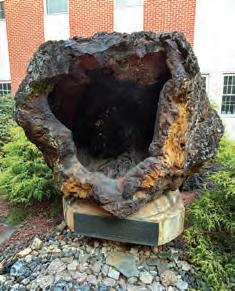
Identify and place this Alabama landmark and you could win $25! Winner is chosen at random from all correct entries. Multiple entries from the same person will be disqualified. Send your answer with your name, address and the name of your rural electric cooperative, if applicable. The winner and answer will be announced in the July issue.
Submit by email: whereville@alabamaliving.coop, or by mail: Whereville, P.O. Box 244014, Montgomery, AL 36124.
Contribute a photo you took for an upcoming issue! Send a photo of an interesting or unusual landmark in Alabama, which must be accessible to the public. A reader whose photo is chosen will also win $25.
Helen Keller was born in Tuscumbia on June 27, 1880. Beset in childhood with seemingly insurmountable challenges, her story continues to inspire.

May’s answer: This statue of legendary college coaches Paul “Bear” Bryant and Ralph “Shug” Jordan was created by sculptor Mark Hopkins in recognition of the Bryant-Jordan Student-Athlete Scholarship Foundation. It is located outside the Alabama Sports Hall of Fame Museum in the Uptown District of Birmingham, attached to the Birmingham Jefferson Convention Complex. The 57th class was inducted into the ASHOF on May 3: Roberta Alison Baumgardner, Keith Butler, Otis Davis, Jason Dufner, Mark Ingram, Mike Mitchell, Charles “Butch” Moore and Frank Warren. The ASHOF Museum opened in 1992 and is home to more than 6,000 pieces of sports memorabilia. (Photo by Allison Law of Alabama Living) The randomly drawn correct guess winner is Lita Callahan of Joe Wheeler EMC.


E-mail us at: letters@alabamaliving.coop or write us at: Letters to the editor P.O. Box 244014 Montgomery, AL 36124 Letters to the editor
Your article (Cup o’ Joe, May 2025) brought back memories from the late ‘60s and early ‘70s. A bunch of us would pile into a car and go to the Montgomery Drive-In at 5354 Atlanta Hwy. It was where the Eastmont Plaza is now. I was never the one to be in the trunk as even then, I was very claustrophobic, still am.
A favorite thing to do was for us to go in a friend’s daddy’s pickup truck. The boy would back the truck into position on the little hill and we would be in the bed of the truck. Drinks (soft), and snacks galore. A bunch of teenagers watching “Tora! Tora! Tora!”, “Bullitt,” “Airport” and “Dirty Harry” on the real big screen. It doesn’t get any better than that.
One bad experience though. Around 1969, I think, I took this girl I had had a few dates with to see “Romeo and Juliet.” She wanted to watch the movie, that’s it, watch the movie. I have never
Before her second birthday, young Helen was stricken with a fever that left her deaf, blind and unable to speak. Rejecting calls to have their daughter institutionalized, Arthur and Kate Keller sought out a private tutor for their daughter. In March 1887, Anne Sullivan, a recent graduate of Boston’s Perkins School for the Blind, arrived in Tuscumbia to teach Keller. There, Sullivan helped open the world to Helen Keller. The “miracle worker” and her pupil were inseparable for nearly half a century.
Keller became a bestselling author in 1903 at just 23 years of age. She leveraged her fame to become an advocate for others in need—the disabled, forgotten and poor—both at home and abroad, visiting more than 30 countries.
Although she left Alabama at a young age, Keller always referred to the Yellowhammer State as her home. Neither have Alabamians forgotten Helen Keller. She was selected to represent the state on its official quarter issued by the U.S. Mint in 2003. Soon, a new statue of her as an adult will grace the grounds of the State Capitol in Montgomery.
A bronze statue depicting a seven-year-old Keller standing at a water pump in Tuscumbia was unveiled in the U.S. Capitol in 2009—one of Alabama’s two contributions to stately Statuary Hall. At the statue’s base are these iconic words from Keller, written in both English and Braille: “The best and most beautiful things in the world cannot be seen or even touched, they must be felt with the heart.” – Scotty Kirkland
watched a Romeo and Juliet movie or TV show since.
The Pratt-Mont Drive-In on Hwy 82 in Prattville was open for 40 years. April 1950 to April 1990. I have some stories about that drive-in as well.
Speaking of the Atlanta Highway, one of the things we guys (sometimes the girls too) from Lee High School liked to do was cruise the Atlanta Highway on Friday and/or Saturday nights. We would go just past the Montgomery Drive-In, make a U-turn, go to Capitol Heights Jr. High School, make a U-turn, and repeat. Gas was about 34 cents a gallon and we would cruise for hours. A friend had a navy blue 1956 Chevy Bel Air and later I had a tan 1966 Chevy Corvair. We thought we had it made.
Thanks for the memories, John Ivey, Wetumpka
The Tennessee Valley Authority Board of Directors selected Don Moul to serve as president and chief executive officer of the nation’s largest public power utility. Moul is the fourth CEO of the historic agency, succeeding Jeff Lyash, who announced his intent to retire in January.
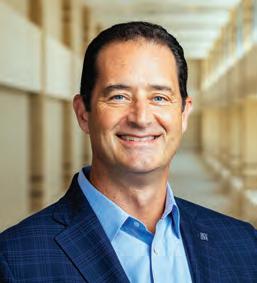
New TVA President and Chief Executive Officer Don Moul.
Moul brings more than 38 years of experience across all facets of power generation. Since June 2021, he has served as TVA’s executive vice president and chief operating officer, where he held primary responsibility for power generation, transmission, and power supply functions.
TVA provides electricity for 153 local power companies serving 10 million people in seven states, including Alabama, as well as directly to about 60 large industrial customers and federal installations. It does not receive taxpayer funding; its revenues come from sales of electricity.
Did we make it too hard for you to find the Dingbat in May’s magazine? From what we’ve heard, it took most of y’all multiple trips through the pages before you spotted the white carnation on Page 32, in the photo of Ewing Steele’s Orange Rolls. Sue Presnall said she found it after looking through the magazine four times. “I had begun to believe that I would just have to give up, when there it was,” she wrote. Cassandra Jones of Hanceville wrote that “the dingbat makes me look forward to my monthly magazines! Such a fun thing to do.” Joyce Porter of Danville wrote us that she found the dingbat long before her husband and son, who were still hunting for it four days after receiving the magazine. “I have searched for many years, page after page,” she wrote. “Some pop right out at you, others are absolutely elusive.” But this time, “I found it on my first flip through the magazine. Combining two of my most favorite things, baking and beautiful flowers. I found this beauty nestled above Ewing Steele’s Orange Rolls, just above the first roll on the right, a sugary snowflake of sorts.” Congratulations, Joyce, for being our randomly selected winner of a $25 gift card from Alabama One Credit Union. Because June is our travel issue, we’ve hidden an oldfashioned suitcase for you to find. Remember, it won’t be in an advertisement or on Pages 1-8. Good luck!
By email: dingbat@alabamaliving.coop
By mail: Find the Dingbat
Alabama Living PO Box 244014 Montgomery, AL 36124
See more travelers on Page 28
We’ve enjoyed seeing photos from our readers on their travels with Alabama Living! Please send us a photo of you with a copy of the magazine on your travels to: mytravels@alabamaliving. coop. Be sure to include your name, hometown and electric cooperative, and the location of your photo. We’ll draw a winner for the $25 prize each month.

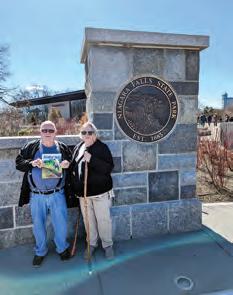


Sponsored by

Dixie EC members Bruce and Shelia Strickland of Ramer traveled to Rome and the town of Kendal in the UK. They visited Sizergh Castle, formerly Strickland Castle, in Kendal where they met with the castle tour guide to learn more about their Strickland ancestry.


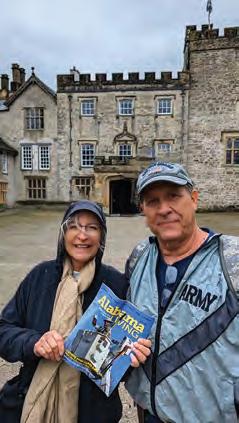
Chris Lilly, head pitmaster and chief operating officer for

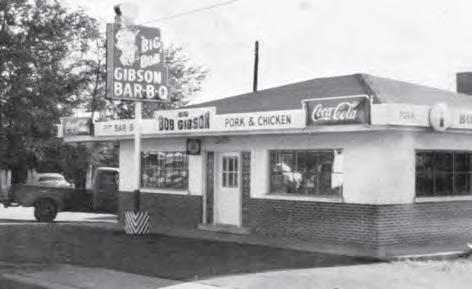



BY AARON TANNER
n 1925, a railroad worker turned his passion for cooking mouthwatering barbecue into a business.
A century later, this passion is still going strong in one north Alabama city as a restaurant that has won numerous awards and spawned a condiment that became synonymous with Alabama barbecue.
Today, this dream is known as Big Bob Gibson Bar-B-Q in Decatur and is a heavyweight among the state’s barbecue joints.
Bob Gibson received his nickname due to his large stature. While working on the L&N Railroad that ran through Decatur, he cooked barbecue chicken and pork shoulder for friends and family before starting a side business on the weekends selling his smoked meats to customers. His barbecue became such a hit that Gibson quit his railroad job and opened his own restaurant, which set up shop in temporary locations based on population movement.
In 1952, a permanent building opened on U.S. 31. The current location on 6th Avenue opened in 1987, with a second location opening on the south side of Decatur on Danville Road in 1992.
All five of Gibson’s children went into the barbecue business. Today, a fifth generation of the Gibson family runs the daily operations at both Decatur locations with help from an energetic staff of employees, some of whom have been there for decades.
Head pitmaster and chief operating officer Chris Lilly, who has been with Gibson’s since 1991, married into the family; his wife, Amy McLemore, is Big Bob Gibson’s great-
granddaughter. Lilly’s father-in-law and Gibson’s grandson, Don McLemore, is the owner.
Thanks to constant business growth under the direction of Lilly and McLemore, the menu is more extensive than a century ago. Originally serving only barbecue chicken, pulled pork shoulder and a few sides, the number of meats smoked and served today include barbecue ribs, chicken wings, brisket and turkey, along with stuffed potatoes and salads. To accompany the expanded choices of barbecued proteins are additional delicious sides like baked beans, redskin potato salad, turnip greens, green beans, and macaroni and cheese.
For dessert, the homemade pies are made from scratch daily before the barbecue gets cooked. “The ladies get there about 5:30 a.m. before the pit guys get there to make the pies,” Lilly says. Some pie flavors made daily include chocolate, lemon ice box, pecan and coconut.
The choices of sauces to top its meats include original barbecue red sauce and vinegar sauce. But it is Gibson’s tangy white sauce made of vinegar, mayonnaise, black pepper, lemon juice, salt, and other secret ingredients – created to moisten the chickens while barbecuing – that became its most popular menu staple and introduced an international audience to Alabama barbecue.
“When I travel around the country and the world cooking barbecue, I have seen white sauce in places such as Ireland, Guam, Australia, California, Miami, and New York, and it makes me proud to see Alabama white sauce that goes back to what Big Bob Gibson started in 1925,” Lilly says.
Gibson’s white sauce and barbecue were wellknown throughout North Alabama for years. When Lilly entered the restaurant’s legendary barbecue and sauces in national cook-offs in the 1990s and appeared on the Food Network in 2000 to tell the story of Gibson and his techniques, the operation grew to nationwide prominence.
“It was my goal to let the whole country know what we were doing in Decatur, Alabama, and how good our barbecue is,” Lilly says. To date, Lilly has won hundreds of awards from competitions, including Memphis in May and the American Royal World Series of Barbecue in Kansas City in such categories as best pulled pork shoulder, chicken, ribs, brisket, sausage and sauce.


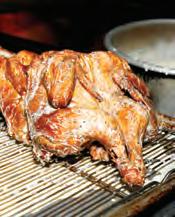
Thanks to television and internet exposure, customers from across the country and the world stop at Big Bob Gibson Bar-B-Q. Along with finding the restaurant’s condiments in grocery stores across the South, customers can order their famous meats, sauces, and rubs on the restaurant’s website and have them shipped anywhere in the United States.
Despite its growth in popularity, nationwide catering business, and being busier with more workers than in the past, consistency of the food, robust community support, and family atmosphere are the secret to its hundred years of success. The barbecue is still cooked and prepared the same way Big Bob did it 100 years ago over hickory wood. “We are still using the techniques and traditions Big Bob Gibson started in 1925,” Lilly says. As a result, customers can expect the same flavor of the meats in 2025 as in the past. “People who ate here in the ‘50s can taste the same profile of the barbecue today.”

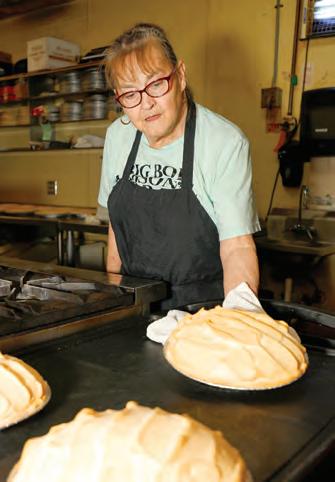
from top: Pitmaster Tyson Daniels readies a batch of barbecued chicken; Three generations of the Gibson family proudly run the business today, including Chris Lilly, (third from left), Gibson’s grandson Don McLemore (second from left) and Lilly’s sons Jacob, far left, and Andrew, far right; Pie maker JoAnn Gunner checks the meringue on one of the restaurant’s popular dessert pies; chicken is marinated in the famous Big Bob Gibson white sauce, left, which is the restaurant’s most popular item and introduced an international audience to Alabama barbecue.
Despite its national prominence, Big Bob Gibson Bar-B-Q still does a robust local business with those who grew up in north Alabama and from transplants who love its legendary barbecue.
In November 2024, The National Barbeque Hall of Fame in Kansas City inducted Big Bob Gibson for his work bringing Alabama barbecue to the culinary forefront. Lilly describes the honor as “realizing how much time and work he (Big Bob Gibson) put into the barbecue and how good it was.”
To ensure Gibson’s legacy continues, Lilly is teaching his adult sons how to cook barbecue on the pit using the same methods Gibson used all those years ago. “You have to emphasize to the next generation how important it is to carry on their family traditions,” Lilly says. In addition, his sons help him run the day-to-day operations of the business, ensuring longevity of the family operation.
To celebrate its 100th anniversary in 2025, Gibson’s Bar-B-Q will run specials throughout the year, including promotions featuring 1925 prices and monthly giveaways. There will also be special 100th anniversary gift cards for sale, online stories highlighting longtime employees, and a community picnic this summer.
To keep up with the anniversary news, promotions, and giveaways, visit Big Bob Gibson Bar-B-Q online at bigbobgibson.com and on all their social media platforms including Facebook and Instagram.

STORY & PHOTOS BY NICK THOMAS

Initially created as the Huntsville-Madison County Botanical Garden Society by a group of local volunteers, the society lobbied the Huntsville City Council in 1980 and was granted 35 acres of land to establish what today has become the Huntsville Botanical Garden.
“The garden has grown since then to 118 acres,” says Laura McPhail, director of communications and guest experience for the public garden
that’s open year-round in the heart of Huntsville on Bob Wallace Avenue.
With over two miles of nature trails and walking paths connecting beautifully themed gardens, woodlands, meadows and water features, the gardens are an oasis in a thriving Alabama metropolis regardless of the season.
“One of the best things about being located in the South is that we can have flowering plants 365 days out of the year with additions like camellias, paper bush, and winter jasmine,” McPhail
says. “When designing garden spaces, we always try to choose a plant palette that will provide four seasons of interest whether with flowers, fall color, or winter interest.”
Annual flowering plants are replaced each year, with some overwintered in a greenhouse to grow larger and create a greater visual impact in the following season’s landscape. Perennials are usually rejuvenated every 3-5 years, which may involve lifting and dividing plants, adding soil amendment, or

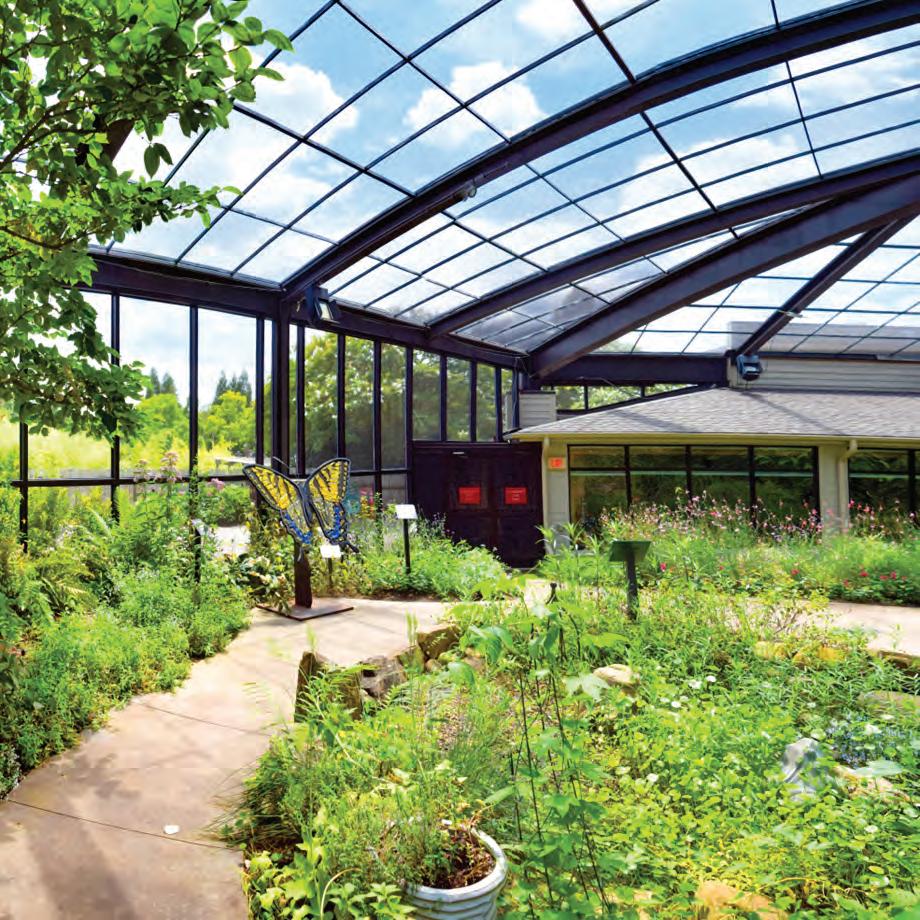

Huntsville Botanical Garden is located at 4747 Bob Wallace Avenue in Huntsville. Admission is $19 for adults, with discounts for students, seniors, and military. Open 7 days from 9 a.m. (11 a.m. on Sundays) until 6 p.m., with extended hours until 8 p.m. May-September. Call 256-830-4447 or visit hsvbg.org for more information or to see the calendar of events.
If you can’t make it to Huntsville, there are plenty of other public gardens around the state that will allow for a family-friendly outing, lots of blooms and beauty and some refreshing shade.
Bellingrath Gardens and Home 12401 Bellingrath Gardens Road, Theodore, AL 36582 Bellingrath.org
Aldridge Gardens 3530 Lorna Road, Hoover, AL 35216 Aldridgegardens.com
choosing a better performing variety, McPhail says. “There are so many types and new cultivars (varieties selected for specific characteristics) coming out every year that you wouldn’t want to keep using the same plants.”
The gardens are arranged around Little Smith Lake, just behind the Guest Center, with an astonishing diversity of features for visitors to discover including azaleas, dogwoods, birding trails, a stunning aquatic garden and numerous other themed gardens. There’s even a maze, a collection of fun oversized outdoor furniture to climb into, a family garden, and an impressive butterfly house.
“Huntsville Botanical Garden is home to one of the largest open air butterfly houses in the country,” McPhail says. To be compliant with the Animal and Plant Health Inspection Service, an agency of the U.S. Department of Agriculture responsible for protecting animal health and welfare, butterflies are not raised
at the gardens. “We order them from a butterfly farm which supplies us with adult butterflies and pupae. The butterfly house is one of our most popular areas.”
Sections of the garden are periodically updated and this April a new area opened called the Mother Earth Troll Garden, featuring a colossal 20-foot-tall troll named Mama Zelda created by Danish artist Thomas Dambo, a world-renowned sculptor who uses recycled material to fashion his art.
While novelty exhibits definitely attract visitors, the gardens are the real stars. Colorful spring flowers bleed into the lush green carpet of summer’s shrubs and trees which give rise to a colorful fall landscape.
“Some trees that produce the best fall color are maples, Chinese pistachio, sweet gum, and hickory,” McPhail says. “Some species are chosen for their fall
Mobile Botanical Gardens 5151 Museum Drive, Mobile, AL 36608 Mobilebotanicalgardens.org
Birmingham Botanical Gardens 2612 Lane Park Road, Birmingham, AL 35223 Bbgardens.org
Dothan Area Botanical Gardens 5130 Headland Ave.; look for the sign on U.S. Highway 431 between Dothan and Headland Dabg.com
Montgomery Botanical Gardens at Oak Park 1010 Forest Ave., Montgomery, AL 36106 Montgomerybotanicalgardens.com
Donald E. Davis Arboretum 181 Garden Drive, Auburn, AL 36849 Auburn.edu/cosam/arboretum


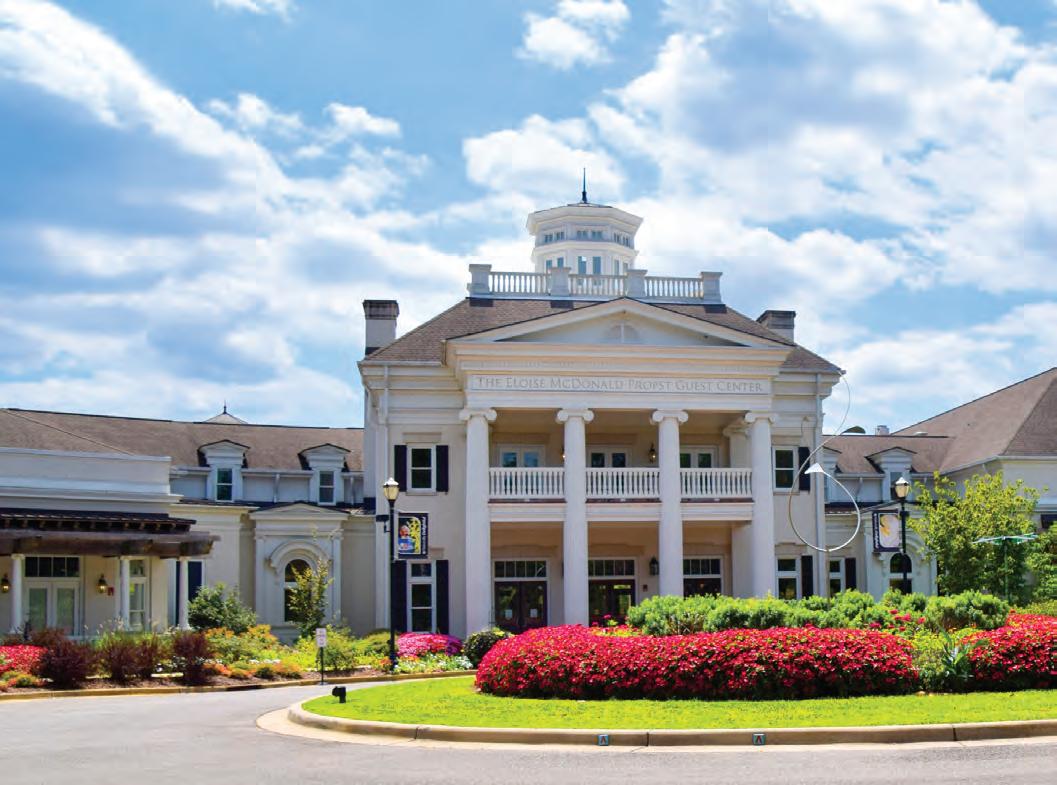

1) The Propst Guest Center is the entrance to the Garden and features the Chrysalis gift shop and the Fern and Feast Bistro.
2) The Wicks Family Garden contains elements to engage visitors of all ages, including dinosaur and space theme displays, a giant sunflower maze and pollywog bog.
color, but usually a selection of a species is chosen. For example, with our native red maple (Acer rubrum) there are many selections that produce more vibrant fall color than the trees found in the wild.”
In addition to garden displays and exhibits, Huntsville Botanical Garden hosts some 70 public events year-round including almost 10,000 participants (students and adults) from 128 school groups that attended STEM field trips in 2024.
“From Fire & Ice in January to raptor shows and plant sales, annual 5K and 3K races, Shakespeare in the Garden performances, and all of the Festifall events, we have something for everyone,” McPhail says. “This summer we will host a Father’s Day Field Day event and a Summer Solstice concert in June. Shakespeare in the Garden will be back for three weekends in July and August
and this year they will perform Macbeth and The Comedy of Errors.”
During the warmer months, visitors can also experience firefly garden hikes and butterfly releases, while the traditional Galaxy of Lights in November/ December allows visitors to “revel in the joy and beauty of the season.”
With extended hours from May through September (closing at 8 p.m.), dusk is a popular time to visit the gardens. “Visitors enjoy the sunset from a variety of areas, but many love to bring their camping chairs and sit by the Floral Promenade adjacent to Little Smith Lake,” McPhail says.
Huntsville Botanical Garden continues to evolve and grow, with a Master Site Plan updated in 2024. It’s designed, McPhail says, “for continuing longterm plans for thoughtful and strategic stewardship of the land.”

BY EMMETT BURNETT
Fort Morgan, the stoic garrison 20 miles from Gulf Shores, is a state historical icon. Children study the fortress of old in history class. Reenactors depict its battles. But the daily activities of the men who staffed the fort are a mystery. Take Lt. Col. Charles Stewart, for example.
Like most Confederate soldiers stationed at Fort Morgan, Stewart faithfully corresponded with family back home. On April 30, 1863, he closed a letter to his wife with, “Love to all, goodbye.” His words were prophetic.
Stewart died two hours later while test firing a faulty cannon. The weapon exploded in a rain of metal, debris, and smoke. Among the scattered remains, soldiers found Stewart’s dentures which are on display at the Fort Morgan Museum.

“Much of what we know about the men today is derived from their letters,” notes Ian McConnell, Fort Morgan’s Culture Resource Specialist, Alabama Historical Commission. “Their letters were long, eloquent, and well written. Most of the soldiers were literate and well read.”
A letter from home was a treasure, sent by boat to fort. However, timeliness was a problem. A letter to Mobile took a month to deliver. A letter from Mobile took a month to receive.
During the Civil War about 1,000-plus troops were stationed at the fort. Some were temporary, awaiting transfers. Others spent their entire career here. Few, if any, were old.
“Many were teenagers,” says McConnell, as we stroll the centuries-old fort. “These guys were in their late teens to early 20s. Officers were older, usually in their early 30s.” Stewart was 35.
“They lived in a very unique environment,” McConnell adds. The fort was as unique as the soldiers it housed.
The same year Alabama became a state, 1819, construction began on Fort Morgan. It took 15 years to build.
Bricks were hauled by oxen carts on a path that is now Alabama Highway 180.
Today the Gulf Shores to Fort Morgan trip by car takes 30 minutes. In 1819 the same trip by brick-loaded oxen cart took 10 days. There were many trips. Fort Morgan is made of 30 million bricks.
From 1819 to 1834 the fort was owned and occupied by the United States. On January 4, 1861, it was seized by the Alabama State Militia. The South took control.
From the thousands who visit Fort Morgan every year, two questions always emerge about the men who made this place happen. “They ask, ‘What did the soldiers eat and do for fun’,” notes the site’s director, Heather Tassin.







From sandcastles to seafood platters, Alabama’s Beaches make summer easy. No long flights, no over-planning—just flip-flops, sunscreen, and beachy dreams.
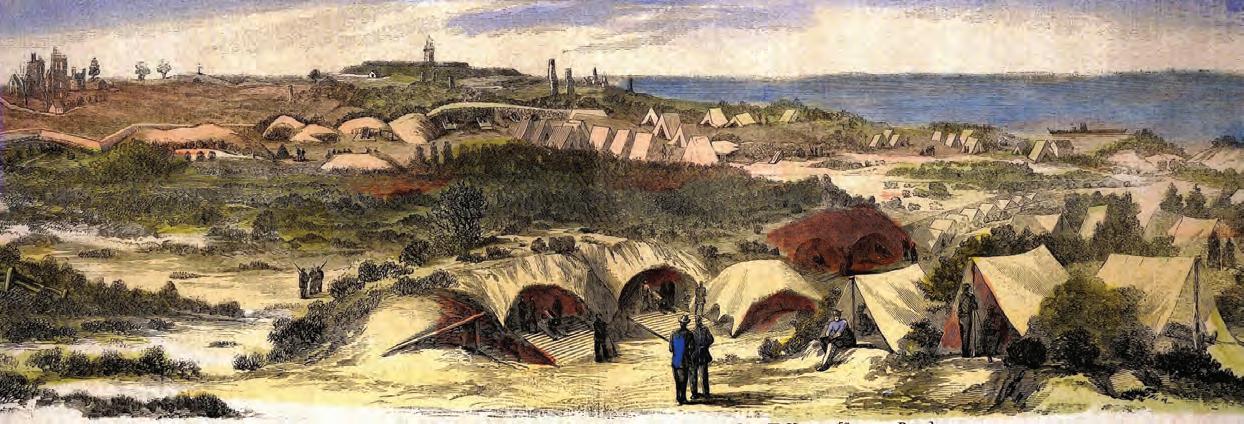
A major complaint of Fort Morgan’s troops was the food, not quality but quantity. “It was never enough,” McConnell adds. “Ration standards included pork, beef, pancakes, biscuits, and hoecakes. Much of their meals depended on the quantity of flour on hand. Flour was gold.”
He also notes, “The only way food could come in the fort was by boats from Mobile. If something cut those boats off, such as Union blockades or skirmishes in Mobile, the food was cut off, too.”
Fort Morgan’s cuisine was also supplemented with Gulf shrimp, oysters, and fish, caught by the soldiers with fishing poles and nets.
“In lean times, fish was a major addition to their diet,” McConnell adds. “Seafood saved the day.”
In addition to fishing, they had other pastimes, but no time was set aside for recreational activities. Free time was allowed only after work and drills were done.
Physical fitness training was not necessary. The men conducted drills daily. They marched and ran everywhere, often with supplies on their backs, up and down Fort Morgan’s steep stone stairways.
One of the most coveted recreational events was the furlough, a soldier’s temporary ticket home. Furloughs were also bargaining chips. Soldiers occasionally sold their freedom tickets to other soldiers.
A week furlough could demand $50 to $80, a lot of money to supplement an enterprising enlisted man’s income. His soldier salary was $40 a week.
Yet Fort Morgan also had chaplains. Grace was said before every meal. Religious services were held twice on Sunday. Prayer meetings were conducted several times a week.
One religious leader set an unfortunate record. Episcopalian Chaplain Noble Leslie DeVotie fell from the fort’s Engineer’s Wharf and was washed out to sea. He was the first Alabama soldier to die in the Civil War.
Soldiers faced many hardships, including homesickness, disease and boredom.
“Just being here was a struggle,” notes Tassin. “The weather conditions, isolation, and no roads were constant hardships.”
She adds, “What impresses me about Fort Morgan’s soldiers is their durability.”

In-fort activities included singing. The men gathered in impromptu groups for songs. Many played musical instruments. They also enjoyed swimming in the Gulf and they also enjoyed drinking.
Whisky was part of the soldier’s rations. It served them well. “The letters home always talk about the other guy’s drinking, not the writer,” laughs McConnell. “It’s everybody but me,’ they would write.”
One man’s correspondence described with pride that his company was one of the most sober in the fort. Another wrote to his family, complaining about leadership’s “do as I say, not as I do” attitude. “They (officers) cannot in good conscience arrest common soldiers for being drunk on duty,” he scribed.
A letter from a private noted, “Fort Morgan is a lovely place to visit but a terrible place to be a soldier.” Another letter described the military fortress: “Being at the front lines is better than being here.”
“Sickness was an issue,” adds McConnell. “The hospitals were always full.” Cholera, tuberculosis, coughs, colds, malaria, and yellow fever were common ailments.
There was also the anxiety of waiting for war. Their concerns were well founded.
In August 1864, Union forces attacked Mobile Bay’s stronghold and its sister, Fort Gaines, in the Battle of Mobile Bay. For two weeks Fort Morgan was pummeled from attacks from land and sea.
A resulting fire raged in the fort’s interior, causing troops to dump its gunpowder in the fort’s cistern, or risk explosion. The action left the Confederate stronghold with little drinking water or ammunition. Outgunned, outnumbered and outplayed, Fort Morgan surrendered in August 1864.
The stronghold’s approximately 1,500 men were arrested and transferred to a prisoner of war facility in Elmira, NY. Others were shipped to similar facilities in New Orleans.
Years later, the fortress would be renovated and activated for military service for World War II. In 1947 the U.S. Dept. of War deeded the fort to the State of Alabama.
Today, facing Mobile Bay at the tip of the Ft. Morgan peninsula, the park and former battleground is a major state tourist destination. The fort still stands.
And in the brick and mortar halls, the memories of those who served and defended the fort still stand as well.






Tell us a little about yourself, where you grew up, went to school, etc.
I grew up in Rogersville in rural Lauderdale County, home to Joe Wheeler State Park which sits on the back waters of the Tennessee River. Early in my adult years I lived in Huntsville where I eventually entered the hospitality and tourism industry. I found the career path I was destined to follow and am now in my 40th year of service to an industry that significantly contributes to Alabama’s economic growth. A just released report by the Alabama Tourism Department states that 29 million tourists spent $23.9 billion in 2024.
How did you get involved with Black Belt Adventures?
conservation efforts through funding, habitat restoration and population management.
Today we include all tourism assets in our marketing and promotional efforts—the rich cultural heritage and history, the talented artists and craft enthusiasts, the cottage industry makers and bakers as well as the many well established restaurants that serve up delicious barbecue, catfish and meat-and-three dishes.
What is it about Alabama’s Black Belt counties that make them unique and “worth the drive”?
Position: Director, Alabama Black Belt Adventures, a public/private sector non-profit dedicated to fostering economic development in Alabama’s 23-county Black Belt region.
Background: 35 years leadership experience in the tourism industry, including with Alabama Birding Trails; marketing entities in North and South Carolina; Decatur/Morgan County Convention & Visitors Bureau; and 10 years in the hotel industry.
Honors & Awards: Many, including the Champion Award from Alabama Tourism Partnership, Tourism Professional Award and Organization of the Year from Alabama Mountain Lakes Association, Executive of the Year from Alabama Bureau of Tourism & Travel.
The Alabama Black Belt Adventures Association initiative was introduced by Thomas Harris, who strongly believed that hunting and fishing was the true economic driver for this rural area in Alabama and a dedicated, strategic plan was needed to attract out-of-state hunters and anglers. With the support of Tim Gothard, executive director of the Alabama Wildlife Federation and then ALDCNR Commissioner Barnett Lawley, founder of B.A.S.S. Ray Scott, founder of Buckmasters Jackie Bushman and funding provided by the state legislature, ALBBAA was launched in August 2009. The footprint was a 23-county area located in south-central Alabama and spanning the distance from Mississippi to Georgia.
I knew very little about hunting and fishing, having not grown up in a family that took part in those outdoor activities. What little I did know, was an invitation I received from the AWF in 2003 to join four other women for their first-ever wild turkey hunt. I accepted the challenge and successfully took two turkeys during the 2004 AWF hunting trip. From that point forward, I became an avid supporter alongside the generations of hunters who have contributed to wildlife
As a native North Alabamian now living and working in a part of Alabama that I knew nothing about, I have grown to love the spirit and personalities of this region’s genuine people. They are the ones that have grown up in this rural landscape and can truly provide authentic experiences for those who seek to immerse themselves in a destination. From hunting, fishing, birding, quilting, marching across history, throwing pottery, enjoying productions by local performers to making biscuits, a visit to the Black Belt is a must on your bucket list.
What motivates you to get up in the morning?
Tourism is a fun and rewarding industry to be a part of and never, ever is a day the same. There is always a new and exciting challenge ahead. What encourages me to land my two feet on the ground every day and start running is the support of a fully engaged board of directors as dedicated as I am in moving the Black Belt’s tourism needle forward.
When you’re not promoting Alabama’s Black Belt, what do you like to do in your free time?
Every chance I get, I love to pick up a paintbrush to hone my skills in watercolor paint, creating landscapes, birds, feathers and other subjects.








Continued from Page 11
Edinburgh Castle in Scotland was the destination for James and Joan Tucker of Moulton. They are members of Joe Wheeler EMC.

Rebecca McElreath of Huntsville, a member of Baldwin EMC, strolled the Appian Way in Rome with her magazine.



Matty Garr of our AREA staff took his magazine along on a snowmobile trip to Trestle Creek in Sand Point, Idaho.
On their trek climbing Machu Picchu in the Andes Mountains in Peru, John and Harriet Jacobs of Woodland, members of Tallapoosa River EC, stopped to get a photo with their favorite publication.
Terry and Brenda Graham of Cullman EC visited The Riverwalk in San Antonio, Texas for their 43rd Anniversary.


BY MYLES MELLOR

JUNE 6
Gordo, Mule Day/Chickenfest, downtown Gordo. This annual street festival features live entertainment, food trucks, street vendors, children’s games and activities, homemade ice cream and a 5K run. A Saturday parade features horses, mule-drawn wagons, antique cars and tractors. GordoAreaChamber.com
JUNE 6-7
Haleyville, 9-1-1 Festival, 922 19th St., 5 p.m.
This family-friendly event honors first responders and supports downtown merchants. Featuring arts and crafts vendors, food vendors, free kids zone, motorcycle show, classic car show and antique tractor show, and Haleyville alumni and First Responders Parade. The Friday night headliner is Parmalee, with more live music all day Saturday. Search for the Haleyville Area Chamber of Commerce on Facebook.
JUNE 6-8
Lake Guntersville, Hydrofest, along Sunset Drive near the Guntersville Recreation Center. Two days of competitive boat racing as drivers volley to take home the Southern Cup. Several classes of boats will compete. ExploreLakeGuntersville.com
JUNE 7
Alabaster, Alabaster CityFest, on the grounds of Thompson High School, 1921 Warrior Parkway. Featuring an all-day KidsFest, live music from Parmalee, Maddie and Tae, Five for Fighting and Eric Essix, and a cruise-in car show beginning at 9 a.m. Event is free with free parking. Bring tents and umbrellas, chairs and blankets. AlabasterCityFest.com
JUNE 7
Foley, Dog Days of Summer, 10 a.m. to 4 p.m., American Legion Post 99. This is a veteran and dog adoption event that features music, a pet parade ($30 per pet), a pet photo booth, arts and craft vendors, food, K9 and police dog demonstrations as well as onsite veteran organizations. Hosted by the Cpl. Joseph Whitehead Marine Corps League. Alpost99.org
JUNE 7
Rainsville, Freedom Run, 8 a.m., DeKalb County Schools Coliseum, 1504 Main St. E. The 17th anniversary of the Rainsville Freedom Run 10K and 5K is for runners and walkers of all ages. Search for the race name at Runsignup.com
JUNE 13-14
Alexander City, 2025 Alex City Jazz Fest. Friday night music at Strand Park, and Saturday night music at The AMP on Lake Martin. Both evenings are 6:30 to 9:30 p.m. Food and beverage vendors on site both nights. Presented by Russell Lands. Alexcityjazzfest.com
JUNE 13-14
Clanton, Peach Jam Jubilee. This free outdoor festival, celebrating Chilton County’s peach crop and growers, features live country music beginning Friday night, arts and crafts vendors, food trucks, inflatables, hot air balloon rides and more. Visit PeachJamJubilee.com for information and a city map that notes all event locations.
JUNE 14
Fort Payne, 12th annual Bluegrass on the Rim, 5:30 p.m., Little River Canyon Center. Concert features Kristy Cox and Grasstime and Foggy Hollow Review. Bring chairs or blankets; leashed pets and coolers welcome. Barbecue and other vendors on site. Adults are $25 in advance or $30 day of the show; students are $20 in advance or $25 day of the show. Kids 10 and under free. 256-845-3548.
JUNE 14
Moulton, Alabama Veterans Uplift, Moulton Parks and Recreation, 13550 Court St. 10 a.m. to 4 p.m. The event is a celebration of Alabama’s veterans and features live music, inflatables for kids, a flag celebration ceremony, recognition of veterans, vendors, bicycle parade, a cornhole tournament and softball tournament. 256-566-4410.
JUNE 14
Wetumpka, River Jam Music Festival, along the riverfront. Live music from multiple genres, beverage tent by Main Street Wetumpka, arts and artisan craft vendors, specialty food trucks and more. This event was previously called the River & Blues Festival. Search for the event’s page on Facebook.
JUNE 20-21
Marion, 30th annual Marion Rodeo, Perry County Cattlemen’s Ralph Eagle Memorial Arena. Cosanctioned by the Professional Cowboys Association and the International Professional Rodeo Association, produced by 3-R Rodeo Company of Jemison. Gates open at 6 p.m., with mutton bustin’ at 6:30 p.m., little wranglers at 7:15 p.m. and rodeo at 7:30 p.m. Proceeds benefit the Perry County Fire Association. 334-410-0748.
JUNE 21
Brewton, Alabama Blueberry Festival, 8 a.m. to 3 p.m. at Burnt Corn Creek Park/Jennings Park. Original arts and crafts, free children’s section, live entertainment, blueberries, blueberry bushes, antique car show, ice cream made specifically for the festival as well as cobbler and crunch. Search for the event’s page on Facebook.

Clanton’s Peach Jam Jubilee celebrates Chilton County’s famous summertime fruit.
JUNE 26-28
Fort Payne, ALABAMA Fan Appreciation Weekend. Features the Teddy Gentry “Singing with the Stars” talent contest, The Buffalo Nickel Coin Show, the Cook Castle Brunch benefiting the Jeff and Lisa Cook Foundation, two June Jam Songwriters Showcases, Randy Owen’s “Fandemonium at the Farm,” as well as other events at the fan headquarters in Fort Payne. The June Jam is on pause this year. Search The Alabama Fan Club on Facebook.
JUNE 26-29
Tuscumbia, Helen Keller Festival, Spring Park. Several events over the weekend, including a free marketplace with arts and crafts vendors, kids’ activities, live music and worship in the park. For a complete list of activities, visit HelenKellerFestival.com
JULY 3
Wetumpka, Independence Day Celebration, 6 p.m., Court Street. This free family-friendly concert and celebration features live music, children’s activities, shopping and vendors. After the concert, head over to the Gold Star Park for a fireworks show. Bring lawn chairs. Search for the event on Facebook.
To place an event, e-mail events@alabamaliving.coop. or visit www.alabamaliving.coop. You can also mail to Events Calendar, P.O. Box 244014, Montgomery, AL 36124; Each submission must include a contact name and phone number. Deadline is two months prior to issue date. We regret that we cannot publish every event due to space limitations.

Alabama Living on FB instagram.com/alabamaliving

BY EMMETT BURNETT
What beats a panoramic view of a Mobile Bay sunset, while dining on Gulf grouper, in a hotel coveted by locals, vacationers, travelers and movie stars? I’ll tell you what beats it:
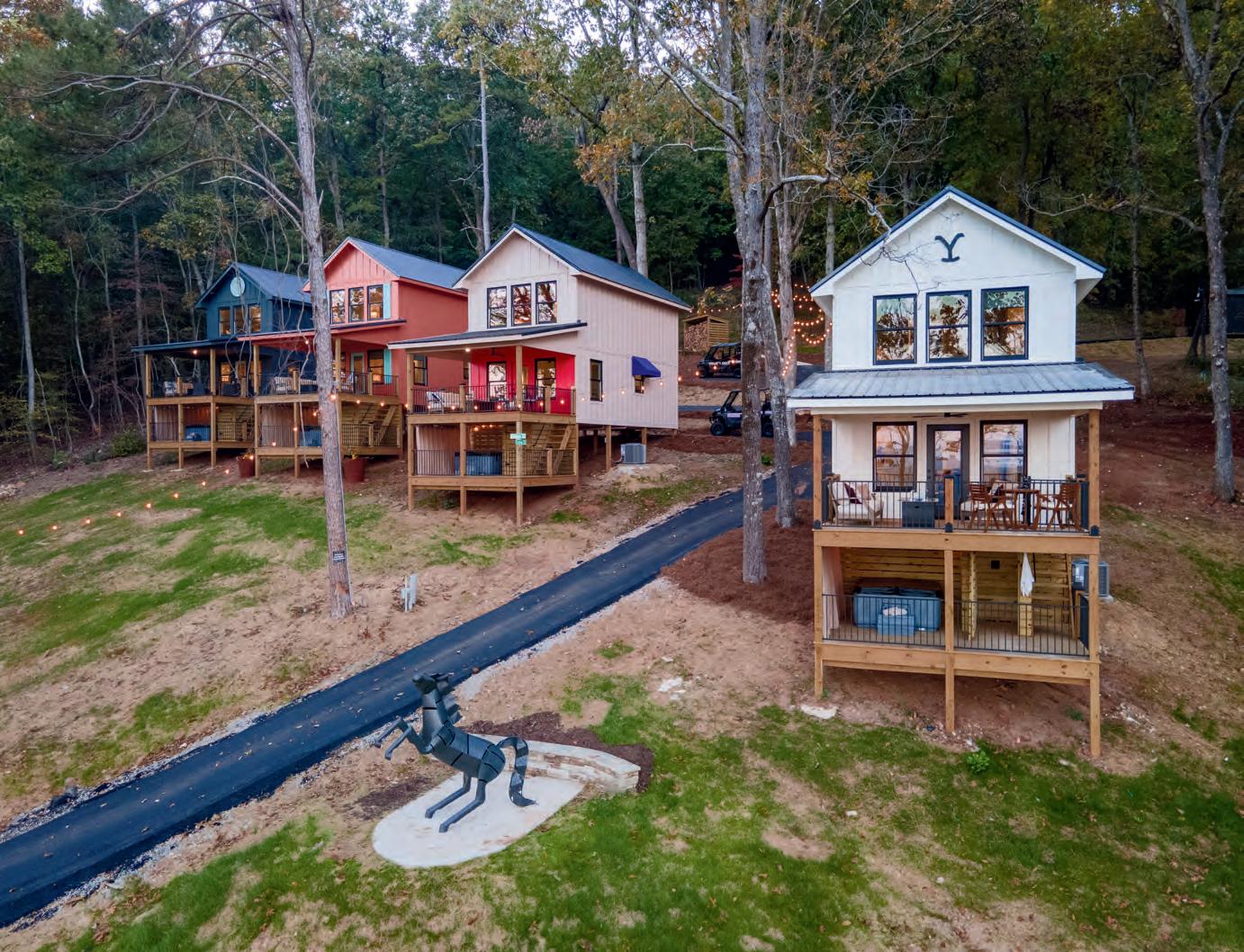
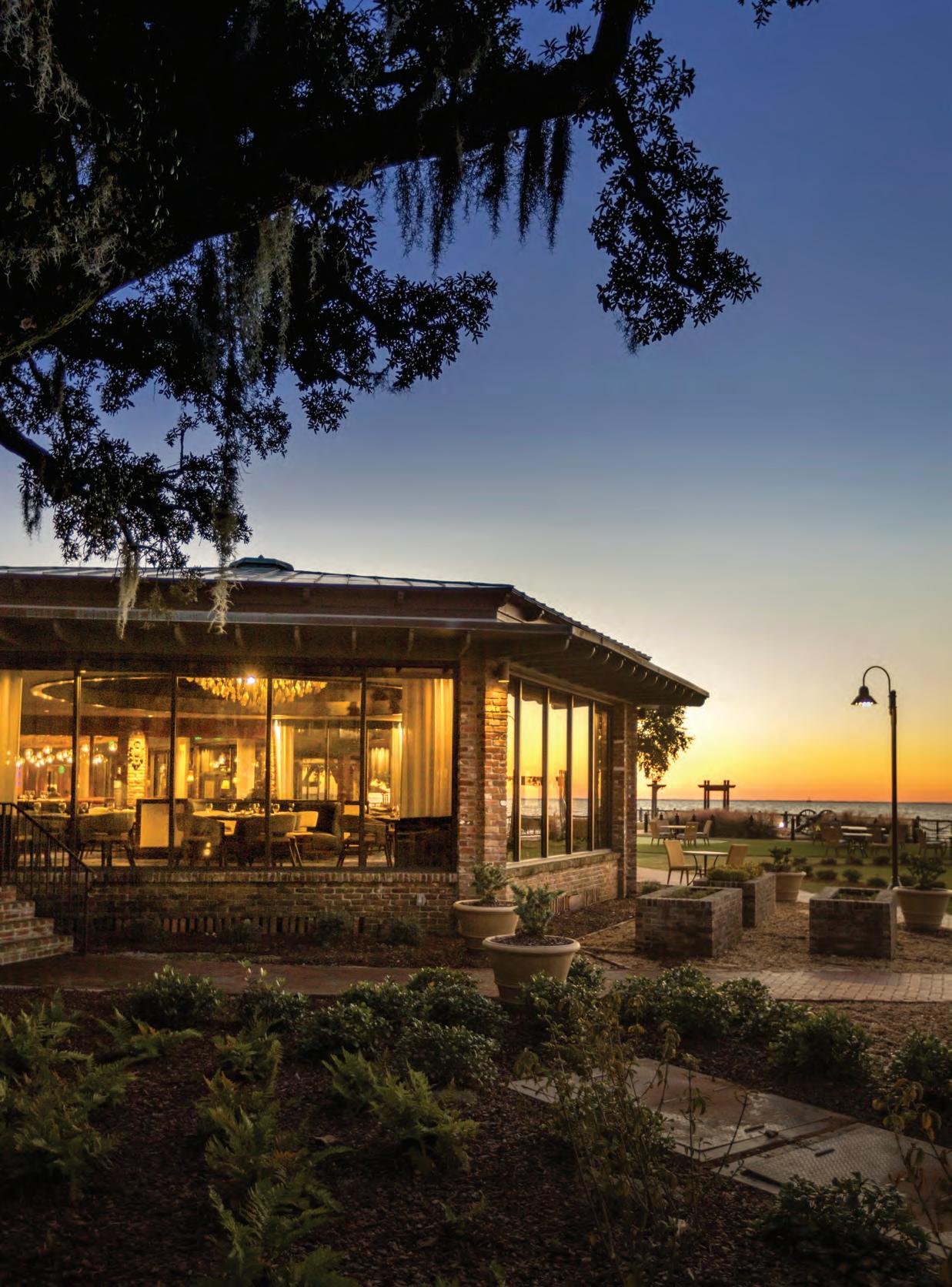



When JB booked her stay at ReTreet Resort’s new Yellowstone Cabin, she expected peace and quiet—but she got so much more. Nestled high above Guntersville Lake, this two-bedroom escape combines rustic western charm with luxurious touches like a private jacuzzi, cozy firepits, and sunrise views you have to see to believe.
charm with luxurious touches like a private jacuzzi, cozy firepits, and sunrise views you have to see to believe.
From the moment she stepped inside, JB was transported. Vintage cowboy hats, open-range-inspired art, and natural textures made her feel like she’d landed in a western dream—without giving up any comforts. Her days were filled with local adventures, from wine slushies and wood-fired pizza at Jules J Berta Vineyards to scenic horseback rides at Guntersville State Park.
From the moment she stepped inside, JB was transported. Vintage cowboy hats, open-range-inspired art, and natural textures made her feel like she’d landed in a western dream—without giving up any comforts. Her days were filled with local adventures, from wine slushies and wood-fired pizza at Jules J Berta Vineyards to scenic horseback rides at Guntersville State Park.
Back at the cabin, evenings were spent stargazing, wine in hand, with nothing but the sound of nature surrounding her. “It was more than a vacation,” she said. “It was a soul-refreshing experience.”
Back at the cabin, evenings were spent stargazing, wine in hand, with nothing but the sound of nature surrounding her. “It was more than a vacation,” she said. “It was a soul-refreshing experience.”
Curious how the spirit of the West meets lakeside luxury? Scan the QR code to follow JB’s full journe —and start planning your own unforgettable escape at ReTreet.
Curious how the spirit of the West meets lakeside luxury? Scan the QR code to follow JB’s full journey —and start planning your own unforgettable escape at ReTreet.
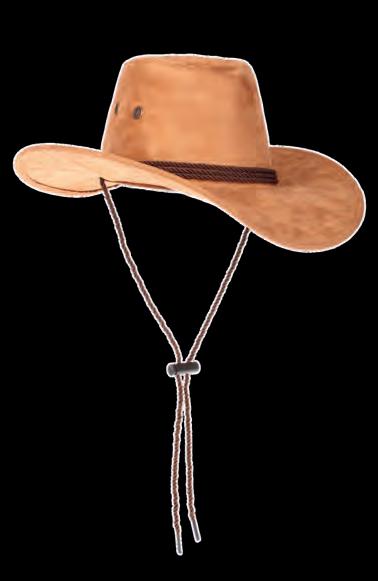

Discover 21 Unique Stays - From Treehouses and Glamping Tents to Cozy Cottages and Two-Bedroom Cabins with Breathtaking Views of Lake Guntersville.
Curious how a stay at ReTreet helped Jonika unplug, reset, and rediscover herself? Scan the QR code below to read her story —and explore how ReTreet offers the perfect space for rest, reflection, and reconnection.
Scan to read JB’ s Story



Such pleasure awaits in a storied state icon. I speak of Point Clear, Alabama’s The Grand Hotel Golf Resort and Spa, Autograph Collection. Exceptional dining exists in all of the hotel’s eight restaurants, but the one overlooking Mobile Bay is a testament to and named for our roots, Southern Roots.
“We specialize in thoughtful, chef-inspired dishes and chef-driven recipes,” says Southern Roots’ Chef de Cuisine, Agustin Echazarreta. “We are a local seafood restaurant and steak house. That is our focus, but we are more.”
Other chefs say Southern Roots is Echazarreta’s brainchild. “He is the man that makes the magic happen,” notes Executive Chef Mike Wehner, speaking about the restaurant renovated around the time of the resort’s 2018 remodeling.
But Echazarreta credits his team, including Executive Sous Chef Markus Hausler and Executive Pastry Chef Kimberly Lyons. Regardless of who does what, the winners are Southern Roots customers.

For this is more than a restaurant. It is an experience that begins at dusk.
“Our sunsets are gorgeous,” notes Hausler, referencing the view outside the restaurant’s panoramic windows. He continues with a smile, “Not only is the sight beautiful, it’s free.”
The menu is beautiful too. Echazarreta adds, “It is difficult to say what a favorite is but among the most popular, I would include our grouper, fresh from the Gulf.” How fresh? At times the fish on the plate was swimming 6 hours earlier. That fresh.

The Alabama ONE Aspire Foundation and Alabama Rural Electric Credit Union, a division of Alabama ONE, celebrate our 2025 ARECU Scholarship winners as they continue their education. The Alabama ONE Aspire Foundation is dedicated to academic and personal development for our fellow Alabamians and is excited to sponsor these awards. We are all proud of their achievements and are excited to see them build a brighter future.
The submission period for the 2026 Scholarships will begin in January 2026. For a reminder when the submission period opens and for more information including eligibility requirements, fill out the form at alabamaone.org/scholarships or use the QR code. Previous applicants can reapply.













“I tell my servers, the fish are so fresh, they’re still smiling,” the chef says, laughing.
Freshness requires good connections with sources.
“The Grand Hotel is a solid customer for our suppliers,” Echazarreta adds. “We work with trusted sources. They give their best of what they have because we have high standards.
“Over the years we built good relationships. In addition to our fish and meats, our produce is sourced from local farmers.”
Continuing with Southern Roots’ insider favorites, Echazarreta notes menu standouts. “Our grouper is served on yellow tomato, risotto with a basil crust on top. It’s a nice technique that complements the fish dish well.”
“My favorite is the tomato pie,” notes Wehner. “It’s a nice southern homey dish with fresh tomatoes and a mayonnaise and cheese crust on it.”
Other preferences include 12-hour braised lamb shoulder, grilled red snapper, beef tenderloin, ribeye steak, heritage beef tenderloin, and beef Wellington.
Southern Roots
One Grand Blvd., Point Clear, AL 36464
In addition to mainstays, there are seasonal dishes and daily specials in a menu that rotates throughout the year. “We are getting grouper in now,” reports Echazarreta. Beginning in March, “It will be available for about three months (through June). Everyone loves it. Our yellowfin tuna and pompano fish are standouts as well.”
251-928-9201
www.grand1847.com/dining#SouthernRoots
Hours: 6 p.m. to 9 p.m. Wednesday-Sunday
Closed Monday and Tuesday l Point Clear

Set on 550 acres of pristine beauty, The Grand Hotel Golf Resort and Spa, Autograph Collection is one of Alabama’s, and indeed the nation’s, premier hotels. Through decades, the Point Clear resort complex has hosted U.S. Presidents, world leaders, movie stars, and families from across the nation. But there is more.
Built in 1847 as two-story lodging with 40 rooms, the Grand Hotel hosted guests who had the means of getting there, which was not easy. “Visitors arrived by steamboat for 50 years, before the Causeway Bridge connected Mobile and Baldwin County,” notes the Grand’s historian, Olivia Vacalis. “Over the early years, the Grand had many owners and many hardships.”
During the Civil War, the Grand served as a field hospital in 1863. “It served wounded soldiers from
Finish the meal with dessert. Kimberly Lyons may hold the happiest job in Baldwin County. She is the Grand Hotel’s executive pastry chef.
“Our Dulcey bananas foster cake is my choice,” she says about the patron favorite. The culinary work of art includes Dulcey mousse, bananas foster sauce with vanilla ice cream, and a pecan crunch.
Three years ago as a test, the Dulcey bananas foster cake was placed on the menu. It never left. Today it rivals a Southern Roots’ and Grand Hotel’s signature dessert, bread pudding with whiskey sauce.
But gourmet dishes of legend are a part of Southern Roots, not the whole. Hospitality is the other part. “Everybody leaving here remembers the hospitality and many have unique stories,” says Wehner, pointing out the window at moms and dads holding their children’s hands, while strolling near the gentle breaking surf of Mobile Bay. “After or before dinner, many guests play games, stroll the boardwalks and make memories.”
He continues, “We have guests returning every year. Some told me, ‘I was raised at the Grand’.”
All four chefs agree that hospitality is who they are. “Good service is expected but hospitality is remembered,” Hausler notes. “Hospitality is what makes the Grand, grand.”
Again, it depends on the season. Call ahead for today’s special.
Like the hotel, the restaurant raises the bar on quality. The Grand’s visitors expect it. After all, this restaurant is part of a hotel with a guest list that has included Bob Hope, Margaret Thatcher, Dolly Parton, President George H.W. Bush and Barbara Bush, the rock group Aerosmith, Clint Eastwood, Willie Nelson, President Jimmy Carter, Rev. Billy Graham, and Lawrence Welk, to name a few.
Now it’s your turn. Reservations are recommended.
the Battle of Vicksburg, Mississippi,” Vacalis says. “Many of the injured, who died on the Grand’s site – hundreds of them - are buried at the nearby Point Clear Cemetery.”
Every evening at sunset, a staff member fires a cannon on the hotel grounds in recognition of war casualties who died in what is now the hotel.
During World War II, the Grand was the training grounds for 5,000 U.S. Army Air Force soldiers in Operation Ivory Soap. “The men knew how to fly planes but not how to use boats, needed to carry equipment and supplies,” notes Vacalis.
Project Ivory Soap was named for the training and its part in the floating depot project. Ivory soap, like the depot, floats.

Over the years, numerous hurricanes have damaged and shut down the Grand. Hurricanes Katrina in 2005 and Frederic in 1979 each caused enough damage to close the Grand for months.
On August 29, 2018, after a three-year renovation encompassing the entire resort, the storied facility and campus were rebranded as The Grand Hotel Golf Resort and Spa.
– Emmett Burnett



The color of a bigleaf hydrangea is influenced by soil pH, with acidic soils producing blue blooms, shown here, and alkaline producing pink blooms.

Hydrangeas are a southern garden classic, loved for their large, showy blooms and ability to add texture and color to the landscape.
Thanks to their versatility, several hydrangea species thrive in the Southeast, if planted and maintained correctly. Here are a few tips for growing healthy hydrangeas in your corner of our beautiful state:
The first step is choosing the right type of hydrangea. Four main species grow well across the region:
• Bigleaf Hydrangea (Hydrangea macrophylla): These are most recognized for their mophead or lacecap blooms. Their flower color is influenced by soil pH — blue in acidic soils and pink in alkaline.They prefer morning sun and afternoon shade.
• Oakleaf Hydrangea (Hydrangea quercifolia): A Southeastern native, it features cone-shaped white blooms that age to pink, with dramatic foliage that turns red, orange or burgundy in fall.
• Panicle Hydrangea (Hydrangea paniculata): Known for their tall, cone-shaped blooms that start white and turn pink. These hydrangeas are sun-tolerant and bloom reliably on new wood.
• Smooth Hydrangea (Hydrangea arborescens): This adaptable species produces large round flower heads on new wood, making them easy to prune and maintain.

Choosing Blue Cross and Blue Shield of Alabama means having coverage that gives you peace of mind.
Discover the benefits of our all-in-one Blue Advantage® (PPO) plans, designed to ensure you get the care you need while keeping your costs low. With Blue Cross and Blue Shield of Alabama, you’ll enjoy:
• A partner dedicated to providing an easy healthcare experience — in 2024, our Blue Advantage plans received 5 stars for Health Plan Customer Service and 4 stars for Overall Star Rating1.
• Access to 90% of doctors and 100% of hospitals statewide1
Call 1-855-978-5194 (TTY 711)2 or visit BCBSALMedicare.com/BA1 to get your FREE Introduction to Medicare checklist.

Scan the QR code with your phone to get your FREE Introduction to Medicare checklist.
Blue Advantage is a PPO with a Medicare contract. Enrollment in Blue Advantage (PPO) depends on contract renewal. Blue Advantage (PPO) is provided by Blue Cross and Blue Shield of Alabama, an independent licensee of the Blue Cross and Blue Shield Association. 1 Every year, Medicare evaluates plans based on a 5 star rating system. Source: BCBSALMedicare.com/whybcbsal 2We are available Monday – Friday, 8 a.m. – 8 p.m. CST. From October 1 to March 31, the hours of operation are Monday – Sunday, 8 a.m. – 8 p.m. CST. You may be required to leave a message for calls made after hours, weekends and holidays. Calls will be returned the next business day.
H0104_NTM25Print_M





Now that you have chosen your favorite hydrangea type, proper placement and planting is key. Due to milder temperatures and more consistent soil moisture, late fall is the ideal time to plant. However, spring serves as a second-best option since soil and weather conditions may be similar to those experienced in the latter months of the year. Select a site with good air circulation and well-drained soil.
Bigleaf and oakleaf hydrangeas do best in partial shade — particularly morning sun with protection from hot afternoon rays. Panicle and smooth types tolerate more sun, making them good choices for brighter spots in the garden.
Dig a hole twice as wide as the root ball but no deeper. Set the plant so the crown is slightly above soil level. Use native soil to backfill the planting hole, and water thoroughly. Mulch around the base with 2–3 inches of pine straw, shredded bark, or similar organic material, being sure to only apply a sprinkle of mulch directly against the crown of the plant.
While these plants are fairly low maintenance, they do benefit from a little attention from time to time. Hydrangeas need consistent moisture, especially during their first year. Water deeply about 2-3 times per week, depending on rainfall. Avoid frequent, shallow watering, which encourages shallow root growth.
Fertilize in early spring using a balanced slow-release fertilizer (10-10-10). Bigleaf hydrangeas may benefit from a second feeding in midsummer. To adjust flower color in bigleaf types, apply garden sulfur for blue flowers or lime for pink.
The most common question I receive about hydrangeas is when to prune. Hydrangeas bloom on either old or new wood, depending on the species, so correct identification and timing are crucial.
• Bigleaf & oakleaf hydrangeas bloom on old wood. Prune just after flowering, before August. Late pruning will remove next year’s flower buds.
• Panicle & smooth hydrangeas bloom on new wood. Prune in late winter or early spring before growth begins to encourage bigger blooms.
A lways remove dead, damaged, or crossing branches any time of year to maintain healthy structure.
W hile hydrangeas have very few problems, a couple of issues may arise.
• Bigleaf hydrangeas are prone to wilting in afternoon heat. This is often normal and temporary, but regular watering and some afternoon shade can help prevent it.
• L ack of blooms may be caused by pruning at the wrong t ime, frost damage, or excess nitrogen. Avoid heavy pruning a fter midsummer, and cover plants during late frosts.
• Fungal issues like leaf spots and powdery mildew are common in humid conditions. Avoid overhead watering a nd space plants to ensure airflow. Remove and destroy affected leaves.
Hydrangeas are well worth the effort and bring timeless charm to Alabama gardens. With a little attention to species selection, watering, pruning, and seasonal care, you’ll enjoy reliable, beautiful blooms year after year.
















Properly insulating while building a home can reduce the expense of your heating and cooling equipment and lead to long-term energy savings.

What are some energy efficiency upgrades I should consider when building a new house?
Prioritizing energy efficiency when building a new home can create future savings and make living more comfortable. It might cost a little more upfront but will pay off in the long run.
Let’s explore two approaches: Following an energy efficiency certification plan or adding energy efficient designs and equipment to your construction project.
There are several efficiency certifications available for new-construction homes that may qualify for discounted homeowner’s insurance, tax credits and other incentives.
Leadership in Energy and Environmental Design (LEED) certification ensures the home uses less energy while prioritizing sustainable resources and healthy indoor air quality. LEED-certified homes use 20% to 30% less energy than the average home — with some homes saving up to 60% — and can cost the same as non-LEED homes with proper planning, according to the U.S. Green Building Council.
Passive House certification requires the home to be so efficient it needs little to no heating and cooling equipment while remaining comfortable for its occupants. To achieve up to 90% less energy use than the average home, the certification focuses on maximizing the efficiency of the building envelope — all components that separate the indoors from the outdoors — including proper insulation levels, air sealing and high-efficiency windows.

ENERGY STAR NextGen Certification for New Homes
recognizes houses that are 20% more efficient than the average home and help reduce greenhouse gas emissions by 40% to 80%.
Although various certifications are available, you don’t have to follow a set guide. Consider adding these energy efficiency principles to your new home build.
Advanced framing techniques maximize the amount of insulated area and save on material costs in wood-framed homes. This technique can save up to $500 for a 1,200-squarefoot home and $1,000 for a 2,400-square-foot home on material costs, between 3% to 5% on labor costs and up to 5% on annual heating and cooling costs, according to the U.S. Department of Energy. Choose a contractor who is familiar with these techniques, and check with your local building officials to ensure compliance with local codes.
The importance of a home’s orientation is often overlooked. According to the International Association of Certified Home Inspectors, homes oriented to the path of the sun use less energy for heating and cooling to reduce energy bills and improve comfort.
If you are building or buying a new home that doesn’t allow options for orientation or framing, you might be able to request higher insulation levels in the attic. Increasing the insulation levels likely won’t cost much more for materials and labor, but it can help you use less energy and save money in the long run.
Heating and cooling equipment should be properly sized using energy modeling tools that calculate the home’s heating and cooling needs. Investing in a more efficient building envelope that is well insulated and air sealed can reduce the home’s heating and cooling load, making it possible to have a smaller, less expensive heating and cooling system. This saves money on equipment costs and lowers energy use.
Optimizing the efficiency of a new home requires a whole-house approach. Analyze all systems and how they work together to ensure maximum efficiency for a safe and comfortable home. Stay tuned for next month’s column, which will include efficiency advice for older homes.
A Significant Historic Landmark.

This historic cemetery honors Confederate soldiers, formerly enslaved individuals, and Horace King, a former slave turned engineer and legislator. It features an interpretive pavilion, walkways, seating, and one of just five remaining King covered bridges. Discover the stories that shaped history at this important memorial. VisitLaGrange com/Mulberry Oh, The Stories You’ll Tell
LEARN MORE ABOUT THIS SIGNIFICANT HISTORIC SITE.


From river rush to canyon hush, Columbus, GA offers the unexpected. Take on the longest natural urban whitewater course in the world, then hike through nearby cliffs carved by time. It’s no wonder we were named one of the Best Weekend Getaways by Southern Living

Over the years, I’ve heard concerned whisperings of the word holistic and its perceived meanings. Because the meaning and origin of the word may not be commonly known and sounds related to the word holy, many people may misunderstand holistic as being tied to New Age spirituality or non-Christian beliefs, leading them to be wary of those who use the term.
However, holistic itself simply means addressing the whole person — body, mind, and spirit — which actually aligns with many religious teachings.
The word comes from the philosopher Jan Christian Smuts, who in 1920 coined the term Holism from the Greek word holos, meaning “whole” and referring to the idea that the tendency of nature is to form wholes, or organisms and systems from the ordered grouping of single units. The term caught on, and the medical community then used it to refer to the different organs in the body and how they relate to each other.

The term wholistic emerged as a variant of holistic around the 1930s, most likely to avoid confusion. While the word is recognized and listed in dictionaries, holistic remains the preferred and more commonly used spelling, especially in academic and medical contexts. Some people also mistakenly believe holistic means rejecting conventional science or medicine in favor of natural remedies, but a true holistic approach combines the best available knowledge from all relevant sources including environmental factors and mental wellbeing. Happy and healthy go together!
So how does that relate to you and your pets?
Both pet and human bodies have 11 intricate major body systems that work together. The integumentary (skin) system, skeletal system, muscular system, nervous system, endocrine system, cardiovascular system, lymphatic system, respiratory system, digestive system, urinary system, and reproductive system. (You can Google for more info if you are the curious sort!)
All these systems “speak” to each other through a series of electrical impulses and chemical reactions (wow, talk about beautifully and wonderfully made!) so you can imagine how a problem in one system, if untreated, will inevitably cause issues in other systems. Like the saying, “Can’t see the forest for the trees” means that when we are just looking at the individual trees, you miss how they are connected to the forest.
Let’s look at a dog with chronic skin issues. It most likely first appeared as red itchy irritated skin and a steroid injection cleared it up like magic, and on the surface, things appeared resolved. The next two times it appears, a nonholistic vet may give another steroid shot along with different antibiotics and maybe an antifungal because now it has smelly, infected sores. And although the medications may have changed slightly,
each time these treatments are becoming less and less effective because the symptoms are getting harder to hide and the root cause has not been addressed.
Along with the first steroid, a holistic vet may add specific herbs or supplements to support digestive and gut health. This is because the gut has its own “brain,” called the enteric nervous system. It controls digestion, motility, and reflexes independently but communicates with the brain. This connection, known as the gut-brain axis, links gut health to skin health, as imbalances in gut bacteria trigger inflammation causing skin issues.
Fascinatingly, it also influences mood and behavior, thus the saying, “I have a gut instinct,” or feeling butterflies in your stomach when in love and unfortunately, the need to use the bathroom when anxious before a job interview!
So what tools (or modalities, if you are into fancy words) does a holistic vet use? Many use pharmaceuticals like every other vet but in smaller doses because it is used with herbs and supplements as in the example above.
You’ve probably heard of acupuncture — a technique using tiny needles to stimulate specific neuro-muscular electrical pathways for pain relief and healing. And you might be familiar with homeopathy, which uses very small doses of natural substances to trigger the body’s own natural healing processes. Now, imagine blending these two approaches by injecting sterile homeopathic solutions into acupuncture points: this is biopuncture. Biopuncture is my absolute favorite. I’ve seen many lame dogs who could not walk healed after a series of treatments when the only other options were hugely expensive surgeries or sadly, euthanasia. I am sure there are many more modalities I’m not mentioning, but I’ve got to go walk my pups.
Talk with your veterinarian about holistic treatments on your pets’ next visit.





















































Summer peaches, which reach their peak in Alabama in June and July, are the source for so many delicious dishes, from jam to cobbler to cake and ice cream. What’s your favorite way to enjoy a ripe peach?

Wanda Stinson of Georgiana has been a regular contributor to our recipe pages, and has placed in several cooking contests over the years, but this is the first time she’s been chosen for Alabama Living Cook of the Month honors. Her prize-winning recipe for “Granie Wanda’s Peach Cake” (Granie is spelled that way because it was the way her grandson spelled it when he was young) was her own creation, but based on a favorite recipe for a peach cake she’d enjoyed for years at Peach Park in Clanton. “I’m originally from Chilton County,” says Stinson, who moved to Butler County in 1986. “I missed the peaches from Peach Park, so when I’d go back home I always got peaches and some of the peach cake they make.” They wouldn’t share the recipe, so she made up her own, which she says is “close” to the one made at the Park. The key is using fresh peaches (preferably from Chilton County, of course), rather than frozen, she advises. “So I wait until peach season!” -Lenore Vickrey

2 sticks sweet cream salted butter, softened
2 cups sugar
6 large eggs
1 tablespoon almond flavoring
1 tablespoon vanilla flavoring
3 cups cake flour
¼ teaspoon baking soda
¼ teaspoon salt
½ cup sour cream
3 cups fresh, ripe but firm peaches, diced
9 ounces apricot or peach Jello, divided
Preheat oven to 350 degrees. Spray tube pan with baking spray. Cream butter and sugar. Add eggs one at a time, beating after each addition. Add flavoring. Sift flour, baking soda and salt. Add flour mixture alternately with sour cream to creamed butter mixture. Fold in peaches and 6 ounces of dry Jello mix; save the remainder for the glaze. Spoon into a pan and bake for 60 minutes or until toothpick comes out clean. Top with glaze.
Peach glaze:
½ cup sugar
2 tablespoons butter
1 12- ounce can Faygo peach soda
2 or 3 peaches, peeled and sliced Reserved Jello powder
Add sugar, butter and soda to a saucepan and bring to a boil, stirring to dissolve sugar. Add peaches and cook for about 2 minutes. Remove peaches with a slotted spoon and set aside for cake garnish. Add the jello, stirring to dissolve and cook 2 minutes. Leave cake in pan and punch holes in cake with thin knife. Pour glaze over cake slowly so that it will absorb. Save a small amount for top of cake. Let stand about 15 minutes. Invert on cake plate. Garnish with reserved peaches and remaining glaze.

Brooke Burks
Some of my fondest childhood memories of summer are of time spent with my Granddaddy, Daddy Joe. We did all kinds of fun things every summer. Bluegrass festivals, yard sales and visiting with neighbors were some of our favorite activities. Every night before bed, we would eat ice cream.
Probably some of my favorite times were when we would visit with his friends and neighbors, the farmers he loved so. We would always come home with arms full of fresh fruit and produce. Now, when I bite into a fresh summer peach, it brings back some really warm memories of my Daddy Joe and all the time I got to spend with him.
When I developed this recipe, I thought of him and how he would love something so simple and so sweet and how it would be perfect to have with our 10 p.m. summer night ice cream. For more memory-making recipes, check out our website at thebutteredhome.com
2 to 4 ripe peaches
1/4 cup brown sugar or sugar-free brown sugar substitute
Preheat broiler to medium to high. Wash, dry and peel peaches. Remove the pits and slice peaches into bite-size slices. Place peach slices on a sheet pan fitted with parchment paper. Sprinkle with brown sugar. Broil 2-4 minutes. Turn peaches and sprinkle with sugar again and broil 2 to 4 minutes. Let cool slightly and serve over ice cream.
1 shor tbread crust (you can also use graham cracker crust)
1 14- ounce can sweetened condensed milk
1/2 cup key lime juice
4 eggs, separated
1/2 cup Mrs. Audrey's Peach Habanero Jam (recipe below)
1/4 teaspoon cream of tartar
2 tablespoons slivered almonds
Preheat oven to 350 degrees. Combine egg yolks (save whites for later), condensed milk, peach habanero jam and key lime juice in a bowl with a electric mixer. Whisk the egg whites until stiff, slowly adding cream of tartar. Add pie filling to crust and top with egg whites. Sprinkle slivered almonds over the top and bake for 15 minutes.
Mrs. Audrey's Peach Habanero Jam:
1 pound frozen peach slices
2 cups sugar (or sugar substitute)
2 tablespoons key lime juice
2 habanero peppers, seeded and diced
Add ingredients to pot and bring to a boil. Turn down heat and simmer covered for 20 minutes. Allow to cool completely before adding to jars. Can be kept in fridge for up to 2 weeks, in freezer for up to 3 months, or you can seal them in a hot water bath. Yield: 2 8-ounce jars.
Audrey Peak Central Alabama EC



Pork-related recipes created or adapted by you. Anything from bbq pulled pork to pork chops and pork loin or even bacon!
When to enter:
Send us your favorite pork recipe by July 4
How to enter:
Mail it to our office: Alabama Living Recipes, PO Box 244014, Montgomery, AL 36124
Email us: recipes@alabamaliving.coop
Visit our website: alabamaliving.coop
Please include the name of your electric cooperative with submission.
4 peaches, peeled and diced
1 tablespoon honey
½ cup plain Greek yogurt
2 cups Half & Half Pinch of cinnamon
Place ingredients in a blender. Blend until smooth. Makes 2 servings.
Linda Persall
Cullman EC
Crust:
1½ cups pecans, chopped
2 cups all-purpose flour
2¼ sticks margarine, softened
Filling:
1 8- ounce package cream cheese, softened
1 pound box powdered sugar
1 12- ounce container Cool Whip
Topping:
1 quar t fresh peaches, peeled and sliced and sweetened lightly
1 cup or bag Wick’s peach glaze
Crust: Mix together flour, pecans and softened margarine. Press into a 9x13inch baking pan. Bake at 350 degrees for 30 minutes or until brown as you desire. Cool.
Filling: Mix cream cheese and powdered sugar. Add Cool Whip and mix well. After crust is cool, spread over the top of the crust.
Topping: After sugar has dissolved, add peach glaze. Mix well and spread over the top of the second layer. Chill and serve.
Cook’s note: If you can’t find fresh peaches, you can use canned peaches. Drain and stir in Wick’s peach glaze or try strawberries with strawberry glaze for a different flavor.
Nellie Wells
Sand Mountain EC
1 or 2 package(s) flakey and layered puff pastry
1 bar cream cheese, softened
½ cup sugar
2 tablespoons sour cream
1 19.4- ounce can peach halves in light syrup
1 egg
Combine the cream cheese, sugar and the sour cream in a bowl, mix well. In a mixing bowl, mash the peaches until there are only small chunks left. Roll out the puff pastry and cut it into any size or shape. I like to make triangles and fold the pastry over the filling or cut a second triangle to place on top. Some prefer to leave them open face. Use multiple pans, if needed. Beat the egg and lightly brush the tops and/or sides of the puff pastry. Put the pans into the oven and bake at 350 degrees for 8-10 minutes. No need to preheat the oven.
Ethan
Williams
Arab EC
½ cup unsalted butter, softened
1¼ cup sugar, plus a little extra to sprinkle on top of muffin mix before baking
2 large eggs, softened
2 teaspoons baking powder
2 ¼ cups all-purpose flour, divided
½ teaspoon salt
½ cup milk
2 cups fresh blackberries (or substitute frozen; thaw and drain)
1½ cups fresh peaches, chopped
Dredge peaches in 1/8 cup flour. Dredge blackberries in remaining 1/8 cup. (Try very hard not to break up blackberries during this step or you'll end up with purple batter.) Grease the muffin tins with cooking spray. Preheat oven to 375 degrees. Combine butter and sugar until creamy. Add eggs, one at a time and mix. Sift all dry ingredients and add slowly to creamed egg mixture.
Gently fold in dredged fruit with a spatula (remember purple batter warning!). Fill muffin tins ¾ of the way for 18 muffins or all the way to the top for 12 muffins. Sprinkle with sugar. Bake for 30 minutes.
Cook’s note: Tastes great with a bit of butter, or even better, honey butter.
Deborah Byrd Baldwin EMC
Peach Cobbler
Peach Mixture:
5 to 6 fresh peaches, peeled, cored, and sliced (about 4 cups)
¾ cup sugar
¼ teaspoon salt
Batter (Crust) Ingredients:
6 tablespoons butter
1 cup all-purpose flour
1 cup sugar
2 teaspoons baking powder
¼ teaspoon salt
¾ cup milk
1 teaspoon ground cinnamon
Add the sliced peaches, sugar, and salt to a saucepan and stir to mix. Cook on medium heat for a few minutes until the sugar is dissolved. This step helps bring out the juices from the peaches. Remove from heat and set aside. Preheat oven to 350 degrees. Slice the butter into pieces and add it to a 9x13-inch baking dish. Place the dish in the oven while it preheats to allow the butter to melt. Once melted remove the dish from the oven.
In a large bowl mix together the flour, sugar, baking powder, and salt. Stir in the milk, just until combined. Pour the mixture into the dish over the melted butter and smooth it into an even layer. Spoon the peaches and juice over the batter. Sprinkle the cinnamon generously over the top. Bake at 350 degrees for 38-40 minutes or until golden brown. Serve with a scoop of ice cream.
Jason French South Alabama EC

Grannie’s Homemade Peach Ice Cream
8 large peaches
1 cup of sugar
3 eggs
2 cans sweetened condensed milk
8 ounces heavy whipping cream
1 teaspoon vanilla
1/4 teaspoon salt
1/2 gallon whole milk
Blend peaches and cover with sugar. Mix eggs, sweetened condensed milk, whipping cream, vanilla and 1/4 teaspoon salt. Add peaches and mix ingredients. Pour into churn canister and add whole milk to fill line. Follow ice cream maker’s instructions for churning.
Dan Canalejo
Pea River EC
Chilton County’s Peach Jam Jubilee will celebrate 20 years of bringing arts and crafts and music to the central Alabama area June 13-14 at Clanton City Park.
“We’re very excited about celebrating 20 years,” says Rachel Martin, executive director of the Chilton County Chamber of Commerce. “We’ll celebrate farmers and peaches, and promote our local businesses and vendors. Vendors come from all over the country as well as locally.” More than 360 vendors are expected, offering everything from jewelry to leather crafts, birdhouses and boutique items. One of the most popular booths is “the reptile guy,” she says, where children can adopt pet lizards and turtles.
This year, an extra day has been added on Friday for a Christian music concert from 5 to 10 p .m. featuring Mac Powell, founder of Third Day, the Lomax Assembly of God praise team and the group Holy Destiny. On Saturday, country music entertainers Larry Fleet and Ashley McBryde will perform, along with newcomer Maggie Baugh. “There’s something for every age group,” says Martin. Kids will enjoy the Kids Zone with its inflatables, and everyone will be able to purchase peaches and peach-related merchandise from local peach farmers at the Farmers Market. “They’ll have a huge spread.”

One group is making the 20-year celebration personal. The 2005 Class of Chilton County High School will have its 20-year reunion at the Jubilee. The class graduated in May of that year, a month before the first Peach Jam event took place, but they plan a special get-together at the park to celebrate. Admission is free. More information is at peachjamjubilee.com or the event’s Facebook page.
ith youngsters out of school, families might want to get outdoors this summer. If someone suggests, “Go take a hike,” don’t get upset!
“Hiking is a great way to get some exercise and be in nature,” explains Nathan Wright, who runs the Pinhoti Outdoor Center in Sylacauga with his wife Kim and serves as the Alabama Hiking Trail Society president. “People can find kid-friendly trails easy enough for entire families to enjoy. Get the kids out into the outdoors. Challenge them a bit.”
Hikers could spend a fortune on special gear, but beginners don’t need much. Just get a good pair of walking shoes.
“Shoes are very personal,” Wright says. “What works for someone might not work for someone else. Try several brands and styles. Get good, comfortable hiking shoes. Gone are the days when people wore big, heavy boots. Gear today is a lot lighter. Most people don’t need a full boot for ankle support. Hiking shoes are sufficient for most people. Tennis shoes are fine for beginners.”
Wear thick socks that provide padding but stay away from cotton. Cotton holds water and provides little insulation. If caught in a rainstorm wearing cotton, a person could get chilly quickly. Wool works in the winter but keeps feet too hot during Alabama summers.
“Wool or synthetics pull moisture away from the body and still have some insulation properties,” Wright says. “Experienced hikers don’t wear jeans, cotton socks or cotton t-shirts. They wear nylon, polyester or other synthetics. I recommend a nylon-spandex mix for hiking in the summer.”
Even for a day hike lasting just a few hours, bring a light backpack. Stuff it with water bottles and high energy snacks or trail mix. Also bring some emergency items, like a first aid kit, flashlight and a way to start fires. Maybe add a thin jacket in case something happens and the hiker must spend the night outdoors. People can download navigational apps on smart phones, but wilderness hikers should bring an oldfashioned compass as well for a backup.

“Be prepared for the unexpected,” Wright says. “People might have to spend more time outdoors than they expected. I recommend picking an area with abundant water. Bring something to filter or purify water. If it’s 100 degrees, a creek looks really tempting, but it’s not safe to drink.”
Throughout Alabama, people can find many places for a short walk in the woods or to take a wilderness adventure. Beginners should stick with easy, well-marked trails that circle back to their cars or pick an easy section on a long trail for a day hike. Don’t overdo it the first time. Many people believe they can do more physically than they really can. Ease into it.
Many wildlife management areas, national wildlife refuges, national forests and state parks across the Cotton State offer places to hike. In addition, people can often find short hiking trails in city parks, preserves, Forever Wild properties and other small wilderness patches. Many wildlife management areas, national forests and national wildlife refuges allow hunting, but hikers will find few people in these lands during the summer with hunting seasons closed.
Before entering an area, particularly a vast wilderness like a national forest, study maps or satellite images. Read about specific trails on the internet. Even on usually wellmarked trails, markers deteriorate or might even disappear over time. Rarely used trails become overgrown.
When hiking, don’t rush. It’s not a race. Stop frequently to observe nature. Look at flowers blooming and watch for birds and wildlife. People might spot white-tailed deer, squirrels, wild turkeys, raccoons and many other creatures. Some parks place resting benches along trails. Have a family picnic.

Tell someone when to expect your return in case something happens. In remote areas, cell phones might not work. Even if the power goes too low, a smart phone screen can reflect sunlight and serve as a signaling device.
Also watch out for other creatures, such as spiders, snakes and bears. Native to the state, black bears still inhabit many parts of Alabama but could appear anywhere.
“Most often, if people leave the wildlife alone, the wildlife will leave the people alone,” Wright says. “People don’t need to break the budget to go hiking. Just go out and enjoy it. See how the kids like it.”
For information on the Pinhoti Outdoor Center, call 205202-9525 or visit Pinhotiforever.com. For information on the Alabama Hiking Trail Society, visit hikealabama.org







-
- 9:39 Sa 28 2:06 - 4:06 2:30 - 4:30 8:33 - 10:03 8:57 - 10:27 Su 29 2:54 - 4:54 3:18 - 5:18 9:21 - 10:51 9:45 - 11:15
Mo 30 3:42 - 5:42 4:06 - 6:06 10:09 - 11:39 10:33 - 12:03
JULY A.M. PM AM PM
Tu 1 4:30 - 6:30 4:54 - 6:54 10:57 - 12:27 11:21 - 12:51
We 2 5:18 - 7:18 5:42 - 7:42 NA 12:09 - 1:39
Th 3 6:06 - 8:06 6:30 - 8:30 12:33 - 2:03 12:57 - 2:27
Fr 4 6:54 - 8:54 7:18 - 9:18 1:21 - 2:51 1:45 - 3:15
Sa 5 7:42 - 9:42 8:06 - 10:06 2:09 - 3:39 2:33 - 4:03
Su 6 8:30 - 10:30 8:54 - 10:54 2:57 - 4:27 3:21 - 4:51
Mo 7 9:18 - 11:18 9:42 - 11:42 3:45 - 5:15 4:09 - 5:39
Tu 8 10:06 - 12:06 10:30 - 12:30 4:33 - 6:03 4:57 - 6:27
We 9 10:54 - 12:54 11:18 - 1:18 5:21 - 6:51 5:45 - 7:15
Th 10 NA 12:06 - 2:06 FULL MOON 6:09 - 7:39 6:33 - 8:03
Fr 11 12:30 - 2:30 12:54 - 2:54 6:57 - 8:27 7:21 - 8:51
Sa 12 1:18 - 3:18 1:42 - 3:42 7:45 - 9:15 8:09 - 9:39
Su 13 2:06 - 4:06 2:30 - 4:30 8:33 - 10:03 8:57 - 10:27
Mo 14 2:54 - 4:54 3:18 - 5:18 9:21 - 10:51 9:45 - 11:15
Tu 15 3:42 - 5:42 4:06 - 6:06 10:09 - 11:39 10:33 - 12:03
We 16 4:30 - 6:30 4:54 - 6:54 10:57 - 12:27 11:21 - 12:51
Th 1 7 5:18 - 7:18 5:42 - 7:42 NA 12:09 - 1:39
Fr 18 6:06 - 8:06 6:30 - 8:30 12:33 - 2:03 12:57 - 2:27
Sa 19 6:54 - 8:54 7:18 - 9:18 1:21 - 2:51 1:45 - 3:15
Su 20 7:42 - 9:42 8:06 - 10:06 2:09 - 3:39 2:33 - 4:03
Mo 21 8:30 - 10:30 8:54 - 10:54 2:57 - 4:27 3:21 - 4:51
Tu 22 9:18 - 11:18 9:42 - 11:42 3:45 - 5:15 4:09 - 5:39
We 23 10:06 - 12:06 10:30 - 12:30 4:33 - 6:03 4:57 - 6:27
Th 24 NA 12:06 - 2:06 NEW MOON 6:09 - 7:39 6:33 - 8:03
The Moon Clock and resulting Moon Times were developed 40 years ago by Doug Hannon, one of America’s most trusted wildlife experts and a tireless inventor. The Moon Clock is produced by DataSport, Inc. of Atlanta, GA, a company specializing in wildlife activity time prediction. To order the 2023 Moon Clock, go to www.moontimes.com.















As you’ve likely seen or experienced for yourself, north Alabama and the entire Tennessee Valley region have grown quite a bit in recent years. All that growth – when it comes to both people and companies - requires power. The Tennessee Valley Authority’s diverse energy portfolio – which includes nuclear, natural gas, hydro, coal, solar and battery storage technologies – meets the electricity needs of more than 10 million customers across TVA’s sevenstate service territory, including more than 1.2 million Alabamians.
To unleash American energy, TVA is making some of the largest capital investments in our history to ensure we have reliable, resilient power today and for the next generation of American industry and jobs. To meet the growing demand for power, we are investing in infrastructure and generation. In addition to enhancements and upgrades to our transmission system, TVA has 5,500+ MW of new power generation planned, with 3,550 MW currently under construction. To put that in perspective, the new power plants that are being built will produce enough electricity to power more than three million homes and businesses once construction is completed in the coming years.

At T VA, an American energy future means creating more energy sources while also improving our capacity to

manufacture or rehab large components right here in the Valley region that are used for producing power. TVA’s Power Service Shops in Muscle Shoals has added equipment, like the PietroCarnaghi vertical turning lathe, which is scheduled to be operational this year. Lathe is a word that you may not hear often. A lathe can hold and turn some of TVA’s largest components, such as the gigantic head covers for our hydroelectric facilities, so they can continue to help keep the power flowing.
The T VA Supply Chain team is building a framework that supports both our immediate operational needs and long-term strategic objectives; this helps ensure TVA has the resources it needs to reach our goals, while managing changes in the market and longer-than-usual wait times for certain products.
As T VA builds for the future, we’ll be asking for public input on proposed projects, and we encourage all communities to learn more and offer feedback. As a federal agency, TVA conducts environmental reviews in accordance with the National Environmental Policy Act. The proposed projects in Alabama and across the region, plus the various ways that you can share your comments can be found on tva.com/nepa. Your voice is a valuable part of the process, and we want to hear from you.


It seems each month I read a report, article or quote from a respected source with yet another warning of the energy shortfalls facing the United States.
More often, the articles I see are from the climate “news” publications predicting our imminent doom if we do not act now to reduce carbon emissions.
When I saw the recent blackouts in Spain and Portugal, it was these climate articles that came to mind. For many years, climate change activists and advocates for “clean” energy, have pushed and protested, in the name of saving the planet, for more renewable energy. It is interesting that the same individuals who are concerned about planetary health are unbothered by the potential of a country with no reliable energy, and that they see no issue with losing the safety, security, prosperity, health and comfort that electricity provides.
generation, that electric providers are responsible for maintaining a stable electric grid that includes reliable energy sources. “While the discrete triggering event isn’t yet known,” Mr. Calzada and Mr. Fernandez Ordonez state, “any reliable grid system must be designed with such events in mind, be they meteorological or technical. A rational system should be designed to handle such events. Spain’s system was engineered politically, and not rationally.”

Climate activists claim renewable power is the answer to the climate change challenge. But recent events confirm what has been said many times over – renewables cannot replace the dispatchable, always-on energy provided by fossil fuels. In an April 30 article in The Wall Street Journal, titled “How the Lights Went Out in Spain,” the authors, Gabriel Calzada and Manuel Fernandez Ordonez, share their opinions on the factors that led to the blackout in Spain on April 28. “Life changed for Spaniards at noon [that day],” the article states. “With the sun at its peak, the country’s largely solar-powered electrical grid shut down. Mere days before, Spain’s government had announced that its grid had for the first time entirely run on renewable power, with new records set almost daily for solar.” The article further states that, following the blackout, Spain’s president, Pedro Sanchez, held a press conference “with havoc in the cities and trains stuck in the countryside [and] with half the country still without access to electricity” to acknowledge the event was “an unprecedented disaster.”
They also mention a fundamental truth of electric

Years of climate change rhetoric and misguided energy polices have led us here. Because electric providers are scrambling to build generation portfolios that can more easily comply with harsh regulation by adding renewable energy sources (often government subsidized) and taking away dispatchable sources, much of the United States is in a situation where weather, and the normal peaks of a year, can threaten reliability. Many electric providers are also in a situation where they simply cannot accept new load growth.
To this point in time, as PowerSouth is in its 84th year of providing wholesale power to its members, it seems the activists have gotten what they wanted. This would have been unthinkable in 1941, when PowerSouth – then Alabama Electric Cooperative –was formed. Charles R. Lowman, former CEO, once recounted not having electricity until 1937. “It was so dark in the country,” he said. “Very dark. I had to study by oil lamps at night and draw water from the well with a rope and a bucket.”
Unlike Spain’s government and President Sanchez, PowerSouth and its members still value aroundthe-clock power and its benefits in our lives. Energy shortages should be a rarity– the first thing you see on the news, not a commonplace occurrence. Perhaps large portions of our country are okay with blackouts because the climate activists’ voices have gotten louder and louder for years, making it seem ridiculous to think in opposition. Perhaps some just wish to return to oil lamps, well water and bedtime at sunset – so long as they can still access Facebook.
I think the people in Spain would agree with PowerSouth. It is better to have reliable power than to be left in the dark.
I hope you have a good month.
Closing Deadlines (in our office):
August 2025 Issue by June 25
September 2025 Issue by July 25
October 2025 Issue by August 25
Ads are $1.75 per word with a 10 word minimum and are on a prepaid basis; Telephone numbers, email addresses and websites are considered 1 word each. Ads will not be taken over the phone. You may email your ad to hdutton@areapower.com; or call (800)410-2737 ask for Heather for pricing.; We accept checks, money orders and all major credit cards. Mail ad submission along with a check or money order made payable to ALABAMA LIVING, P.O. Box 244014, Montgomery, AL 36124 – Attn: Classifieds.
THE FRUGAL INVESTOR NEWSLETTER – www. thefrugalinvestor.com – FREE Trial – S&P 500 stock selection guide
PRESERVE YOUR HOME AUDIO and VIDEO MEMORIES. We transfer VHS and most other formats to CD, DVD, or USB. With over 20 years of experience, dedication and trust. Located in Andalusia, Alabama. Please call (334)440-7711.
MENTONE, AL LOOKOUT MOUNTAIN COTTAGE RENTALS – Best brow views, River Front –cottagesofmentone.com, Call or text (504)4818666
Pet friendly – Save $$$ by booking directly from Verified Owners. ALAVHR.com
Answers to puzzle on Page 28


PANAMA CITY BEACH CONDO – Owner rental – 2BR / 2BA, wireless internet, just remodeled inside and outside – (502)7777819, larrysusemichel@reagan.com, www. theroneycondo.com
Pet friendly – Save $$$ by booking directly from Verified Owners. ALAVHR.com
PIGEON FORGE CABIN – Private and convenient – Sleeps 6 – Over 2 acres – 4 miles to Parkway. For more information pictures, etc. go to vrbo. com number 189535, but contact owner directly to save booking fees. hilltopakc@yahoo.com –(334)365-6976
MILITARY / SERVICE DISCOUNTS on dozens of rentals. No Booking Fees. (251)333-6500, ALAVHR.com
OWNERS – Join the fastest growing regional site in Alabama. Low annual fee. Verified Owners, no booking fees or commissions. Alabama Vacation Home Rentals. Locally Owned and Operated. (251)333-6500, ALAVHR.com
GULF SHORES BEACHFRONT CONDO - Owner rental, 2 bedroom / 2 bath, Sleeps up to 8Westwind Complex, call or text (580)380-9882 or email conlou3@yahoo.com
GULF SHORES / ORANGE BEACH / FORT MORGAN – Choose from hundreds of beach houses and condos! Verified Owners. No Booking Fees. ALAVHR.com
GULF SHORES BEACHFRONT – 2BR / 2BA –SANDPIPER – Call Deb (502)386-7130

ABSOLUTELY LOWEST PRICES ON THE BEACH! Affordable Beachfront & Beachside Vacation Condos – Sugar Beach Condos in Orange Beach, AL. Rent Direct from Christian Family Owners. –www.gulfshorescondos.com, (251)752-2366.
FREE MATERIALS: When Church / Government Unite, Enforcing Sunday Law, The MARK OF THE BEAST is HERE! Don’t be deceived, be informed! Leave mailing address only – TBSM, POB 374, Ellijay, GA 30540 – TBSMADS@yahoo. com – (888)211-1715
FREE BIBLE CORRESPONDENCE COURSE –write to P.O. Box 52, Trinity, AL, 35673




For me, it’s fitting the final round of the U.S. Open is almost always on Father’s Day. That’s because it reminds of my dad who taught me how to play this maddening game. I still don’t know whether to thank him or curse him for introducing me to a sport that is so humbling, frustrating, and difficult. But he did; you see, my dad didn’t do anything else. He didn’t hunt or fish, and he was no handyman. But the man could play golf, and had a passion for the sport that was unrivaled. He was a skilled player. Dad even carried a 1 iron, the most challenging club for any golfer to hit. Lee Trevino put it best when he said, “If you are caught on a golf course during a lightning storm, hold up a 1 iron. Not even
God can hit a 1 iron.” But my father could. So, naturally, I thought I could hit it, too. In fact, from my teens until my fifties, you could always find one in my bag.
Growing up, we frequently played together on summer afternoons with my mother. I still laugh when I think about the time he picked up a grasshopper and flipped it on her. It stuck to her rayon blouse like a piece of Velcro. I’m sure her screams were heard three counties over.
A few years later, I occasionally played with dad’s Saturday morning group, on opposite teams, of course. As a result, I frequently experienced his gamesmanship skills. He would pepper me with heckles and taunts, especially if the shot was meaningful.
We absolutely hated losing to each other. Consequently, there was nothing sweeter than beating my old man out of a buck or two. Naturally, I never took his money.
In later years, an infection from a knee replacement ended his playing days. Eventually, it cost him his leg, and finally, his life. I know that something in both of us died when he gave up the game. It was special sharing golf with him. And now it was gone.
A short time after he passed away, I knew what I had to do. It was time to give dad a special tribute I’d planned for a while.
I went to my golf bag, dug into a side pocket, and pulled out three new Titleist golf balls, his favorite. Using a Sharpie I wrote, “Thanks Dad” on each one. Then I grabbed a special club and headed for the course I grew up on. It was a quiet, reflective drive.
In about half an hour, I turned onto the road that leads to the clubhouse. What a lovely mid-October afternoon it was. The air was dry and comfortably warm. The leaves had traces of crimson and yellow; their technicolor show was still a few weeks away. It seemed especially quiet, as if nature was showing respect for the occasion.
I grabbed the club and balls, then began walking from the parking lot to the 18th tee. Even though the sun was setting, there was enough light for what I had to do.
I teed up the first ball and took a couple of practice swings. Then facing the large lake that flanked the tee and fairway, I said, “This is for you dad,” and hit the first ball with his 1 iron.
What a lousy shot. It flew about 150 yards, skipped twice, and plopped into the water. Ugh. Stiff muscles.
The second shot was better, but still didn’t come close to the high standard I had set for myself on this day.
This left one more ball. One more chance for a golf shot that I desperately wanted to hit well. I took a deep breath, and made a long, fluid swing. The Titleist solidly hit the center of the club face and leapt into the fading light. I held my follow through until it splashed and disappeared in the water.
I stood silently on the tee for a few moments and allowed old memories and the pain of my father’s loss to wash over me. Finally, I dried my tears, walked to my car, and drove home, feeling like his death had lost some of its sting.
Happy Father’s Day, old man. I’m sure you’re golfing on two legs now, certainly on a much nicer course than I play on. We’ll tee it up again before you know it.



